Vintage News 2018
Top of the pile – the humble CCT – Dec 2018
Winston Churchill once said “a nation which forgets its past has no future”. The LNERCA certainly subscribes to this view and, being a diminishing breed of preservationists, subscribes to these wise words in that we are trying not only not to forget our past, but actually preserve it as well. Every heritage railway in the country has something in common – derelict vehicles, eyesores and wrecks. The good aspect about them is that they have escaped the breaker’s yard and await their turn for restoration. The downside is their appearance. Welcome, therefore, to this episode of the ‘wreck restorers’.
For some months, in between the huge effort expended on East Coast Joint Stock Restaurant Third No. 189 in preparing it for its successful exhibition at the 1940s Weekend, we have been working hard on renovating our trusty, decidedly tatty and forlorn stores van, alias Covered Carriage Truck (CCT) No. E1308. Although work continues on No. 189, we have the opportunity to have the CCT in the Atkins shed for up to three months. Here, thanks go to not only Kieran Murray, C&W Engineer for allowing us the space, but also the Pickering Wagon Group which has just completed its outstanding restoration of the Pipefit wagon. With some of its Group’s volunteers sampling NHS hospitality, the suggestion was made to have the CCT under cover using the allocated wagon space which will aid its renovation enormously.
One side has been completely rebuilt, new vertical boarding and new doors. The roof has been stripped down to the roof boards only to reveal it is in far better condition than was expected. Only two roof boards were in need of replacing at one side where they join the cantrail (top of the van side).
Several roof boards had ‘lifted’ i.e. the screws holding them to the metal carlines (hoopsticks which span from one side to the other) had lost their ‘bite’ so we began the painstaking task of removing all the rusty screws, derusting the carlines, painting them in green anti-oxide paint, then undercoat and using bolts to secure the roof boards to the carlines. When all 16 carlines have been treated, then a new roof covering will be fitted – type to be determined.
No. 1308 will be permanently stabled in Pickering, so will look pristine to visitors. We are using some artistic license in that although it was built in 1950 (to an earlier 1939 LNER design) and would have emerged from York Works in maroon, we are painting it in the 1939-style LNER Brown with LNER-style lettering.
The CCT ran for 27 years on BR, all over the country. It was withdrawn on January 12, 1977 at Doncaster. The CCT was then given an Internal User number for use within Doncaster Works and, finally, was used by the Works’ Horticultural Society. When this was disbanded in 1996, the Works’ staff most kindly donated it to us and it arrived in July of that year. For those interested, its full history is on the LNERCA website – see: https://www.lnerca.org/home/wp-content/uploads/2017/03/E1308-F.pdf
It is hoped that NYMR members and readers will appreciate that the LNERCA is not only restoring passenger-carrying carriages, but non-passenger types as well, for it is the latter which can no longer be seen on the national system, eg, parcels vans, full Brakes and Fish Vans. It is these vehicles which add the atmosphere and ambience to a heritage railway as we try to recreate and recall by-gone railway times.
Pastures new
Two of our vehicles have left for a new home at Kirkby Stephen. North Eastern Railway Luggage Composite No. 1111, the van which has resided at Levisham for a staggering 45 years. Is to be restored by a group based at the Stainmore Railway. It would be many years before the LNERCA could return it to operational standard, so in its long-term interest, this was considered the best option, the LNERCA retaining ownership.
Also heading to this thriving railway is Gresley Brake Third Corridor No. 3669 where covered accommodation has been offered. This is so important for the well-being of the varnished carriages. It will return, come the day it can be put under cover on the NYMR. No. 3669 has been the Brake carriage for the LNER set during 2018 whilst Brake Third Open No. 43567 has been used in the Pullman set, deputising for Car No. 79.
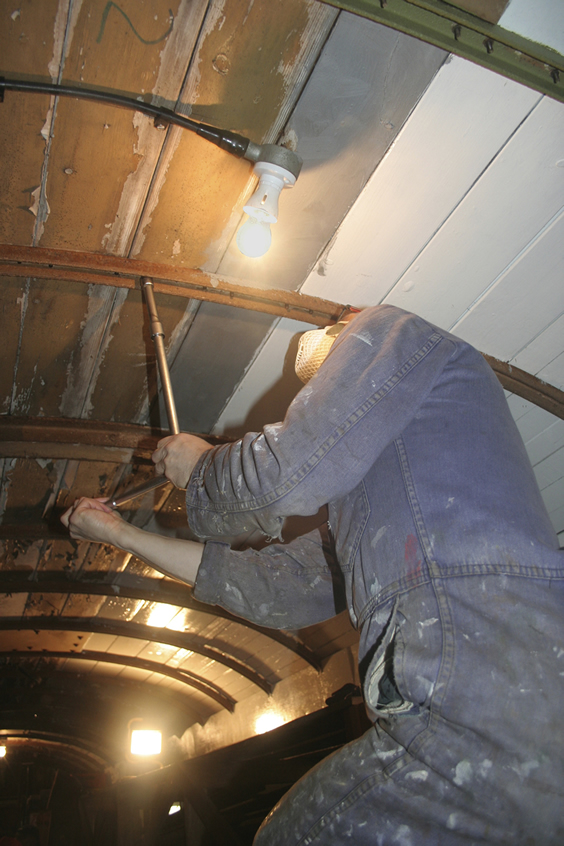
There has been a hive of activity in the Atkins shed at Pickering where the LNERCA’s stores van, CCT No. E1308, has been receiving major attention. This amounts to a complete renewal of all external woodwork.
Not only that, but inside, all the rusty screws which hold the roof boards onto the carlines are being removed and replaced by bolts, inserted from outside and nutted from inside.
The carlines have been derusted and painted with anti-oxide paint, whilst all internal roofboards are being painted white. Here, Nick Smith tightens one of the hundreds of new bolts which will ensure the roof boards will not ‘lift’ off the carlines. Photo: Murray Brown.
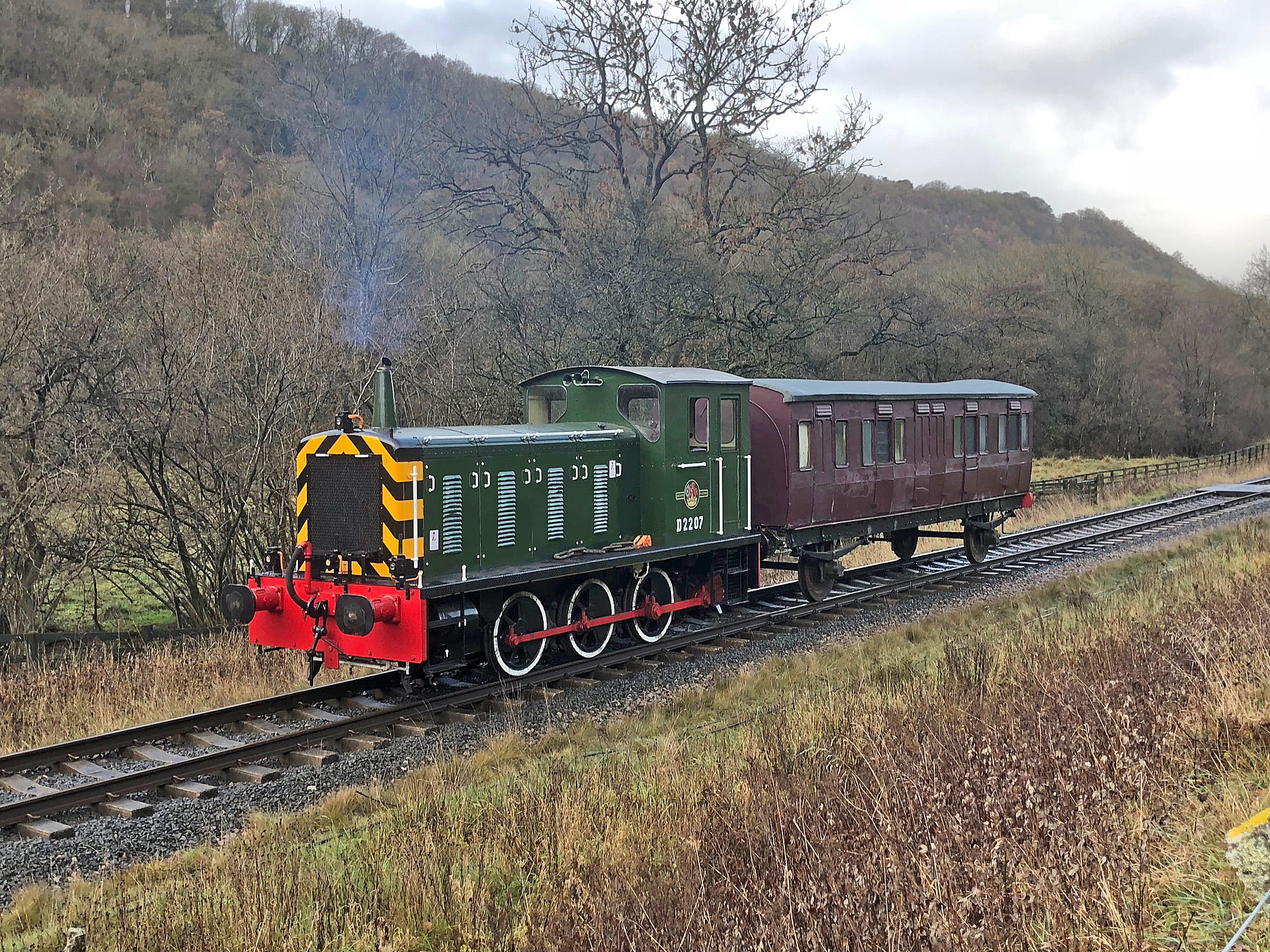
Newly restored Class 04 Drewry shunter No. D2207 hauled NER Luggage Composite No. 1111 from Levisham to New Bridge on November 20 for onward road movement to the Stainmore Railway where restoration will be put in hand. No. 1111 has resided at Levisham for 45 years and this was only its second journey, the first being when it was moved from New Bridge To Levisham in 1973. Photo: Kieran Murray.
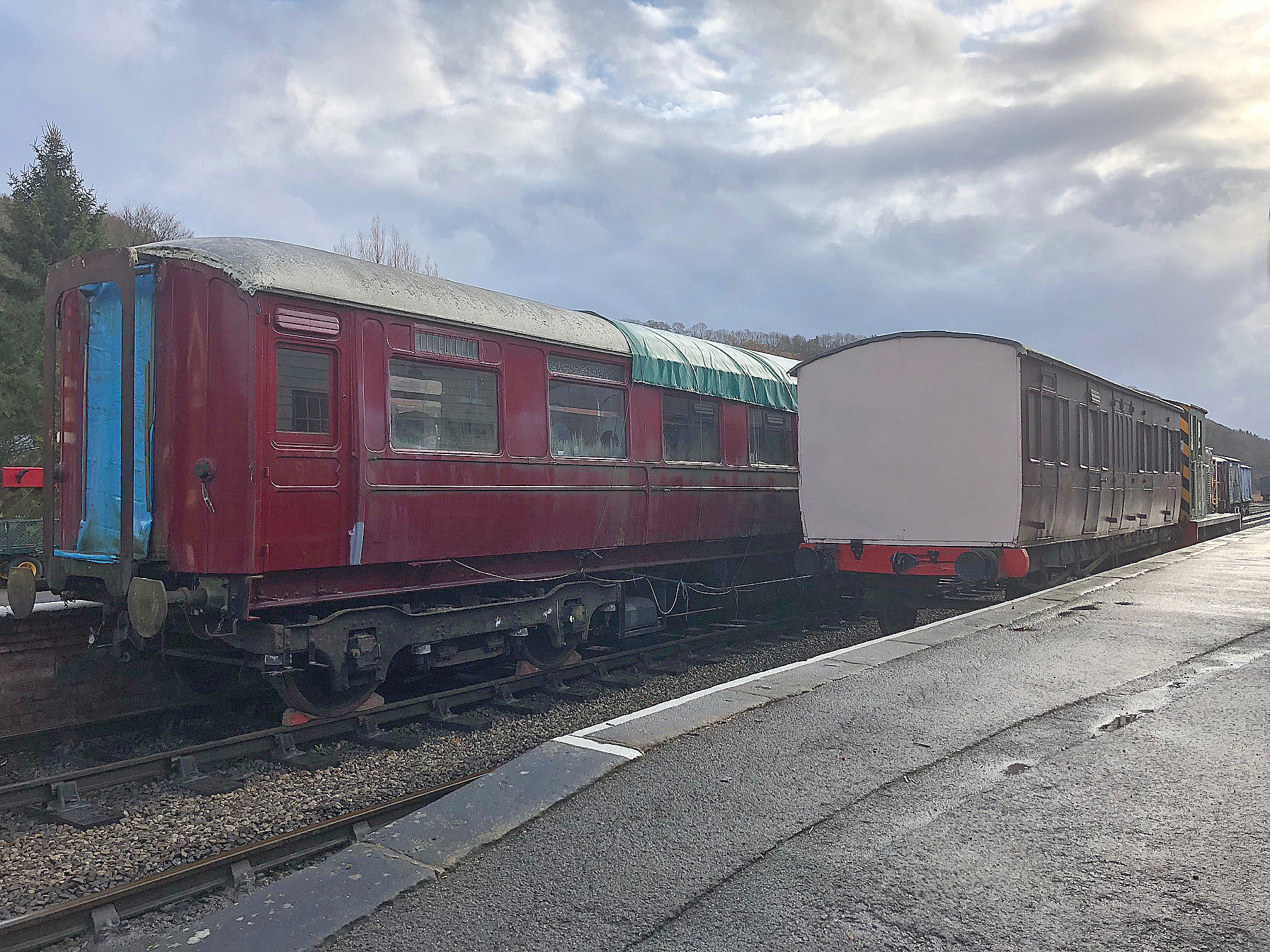
A large shunt was required at Levisham to extract No. 1111 from the dead-end siding. This entailed removing all the stock in front of it, which included the North Eastern Railway Coach Groups’ Third Open No. 945 built in 1924 to a NER design. This carriage, too, will be moving to Pickering in 2019 so that the LNERCA can swap its bogies for overhauled ones and replace the roof canvas. For many years, the end of No. 1111 was adorned by a ‘face’ in order to appeal to children – but not appreciated by connoisseurs of NER heritage rolling stock. Photo: Kieran Murray.
Unique Thompson carriage passes to LNERCA – Nov 2018
In recent years, the saga of 1947-built Thompson-designed Composite Lavatory (CL) No. 88339 has not been a happy one. This consortium-owned carriage ran highly successfully for several years at the north end of the LNER set (so allowing access to the compartments at all station platforms). However, in 2012 it was withdrawn from service due to faults with its doors, and since then it has been stored in a siding at Levisham. Although under an agreement with the consortium, the NYMR was responsible for its maintenance, it was always low down the list of priorities, so nothing was done and it looked like continuing that way for the foreseeable future. As a result, No. 88339 has deteriorated further, and the owners had to provide a tarpaulin to try and stem further damage.
Committee members of the LNERCA, worried that this historical, unique carriage and so representative of the type which worked the Whitby services prior to BR closing the line, was ‘getting nowhere’ came up with the idea that if ownership could be transferred to the LNERCA, this would open the door to a better future. It is pleasing to report that all the shareholders have agreed that this is, indeed, the best course of action – and ownership of No. 88339 has now been transferred to LNERCA.
The present thinking is that if its repair is regarded as a joint venture, with the LNERCA providing labour and the NYMR providing materials, the cost of repairs can be significantly reduced.
No. 88339 will have to wait its turn – the LNERCA is committed to finishing No. 189 and NER No. 945. In the meantime, thoughts are being given to safeguarding the carriage and preventing further deterioration. Several options are being explored but it would be premature to name them.
If the carriage does leave the NYMR (a possible option) for storage and repair, the Trust Board is keen for it to return. The new contract between LNERCA and the NYMR would transfer maintenance responsibility to LNERCA, and the NYMR would pay a hire charge per mile, with a minimum mileage per annum. In this way the coach can be guaranteed to be used, and the impasse that has occurred over the last eight years about its maintenance would not be repeated. A win-win for both parties
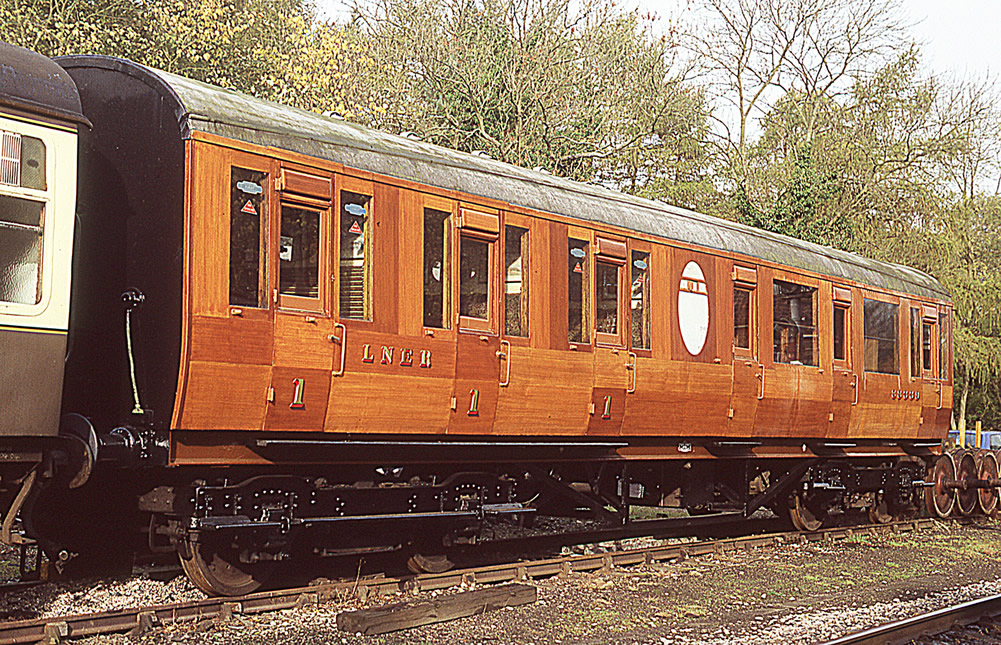
The clock is turned back to happier days for CL No. 88339 – October 26, 2004 when it had just been ‘scumbled’. The possibility is now on the cards that this condition will one day be recreated. Photo: David Idle.
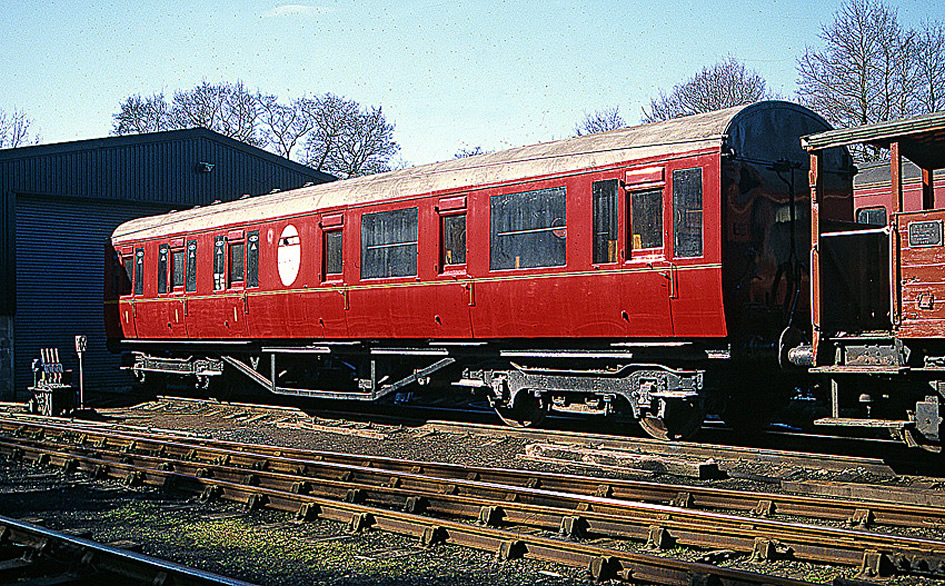
No. 88339 has also carried maroon livery during its near half century on the NYMR.
It was withdrawn in June 1967 in Scotland prior to arriving on the NYMR in March 1970.
Photo: Murray Brown.
ECJS No. 189 transformed for Wartime exhibition
A herculean effort by volunteers saw East Coast Joint Stock Restaurant Car No. 189 totally transformed to take part in the Steam, Speed and Sumptuous Dining’ exhibition which took place during the NYMR’s Wartime Weekend. To get to this stage, an enormous amount of work was put in, led by Marcus Woodcock and his merry men.
From what was still very much a skeleton shell, parts of the 1894-built carriage were dramatically changed – with ceilings and panelling in place.
Visitors first saw the pantry. Not long ago, this didn’t exist but partition and cupboard was now in place and furniture was varnished, installed and displayed ECJS silverware. There was a mock-up of the carriage designer’s drawing office (David Bain) with drawings and pens depicting the carriage design being finalised. The next stage depicted the First World War through which the carriage survived – a dug-out with sandbags, very much in keeping with this year’s 100-year anniversary of the ending of WW1. The final section was the eye-opener – two tables set for diners. These even has ECJS plates, a bottle of ECJS Claret and Port. There was even a carpet down the middle of the carriage – a foretaste of things to come.
There were some 1,600 visitors who enjoyed the exhibition, the participants wearing a headset and listening to the fictional tale of ’Nipper’ who was a pantry lad relating his life through the years.
What was particularly rewarding was the fact that the Heritage Lottery Fund was most pleased to see this exhibition as part of the HLF-funded project.
Special mention and thanks to must be made of Helena Fox, the NYMR’s Education Officer, and Wendy Taylor, our Education consultant, for all their skill and effort in putting the show together. The accompanying graphics – posters and prints and attention to details – were outstanding. Because the exhibition was so successful we’ll try and repeat it at some point in the future.
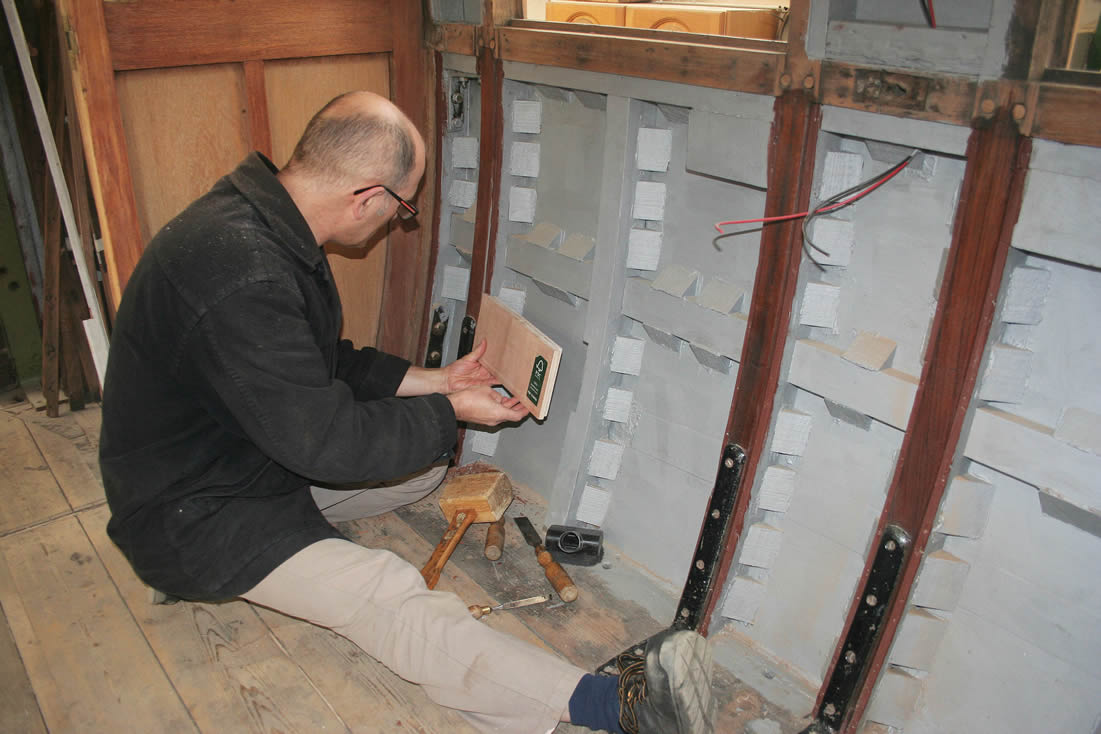
Nick Smith fits a supporting panel between the half-pillars.
Photo: Murray Brown.
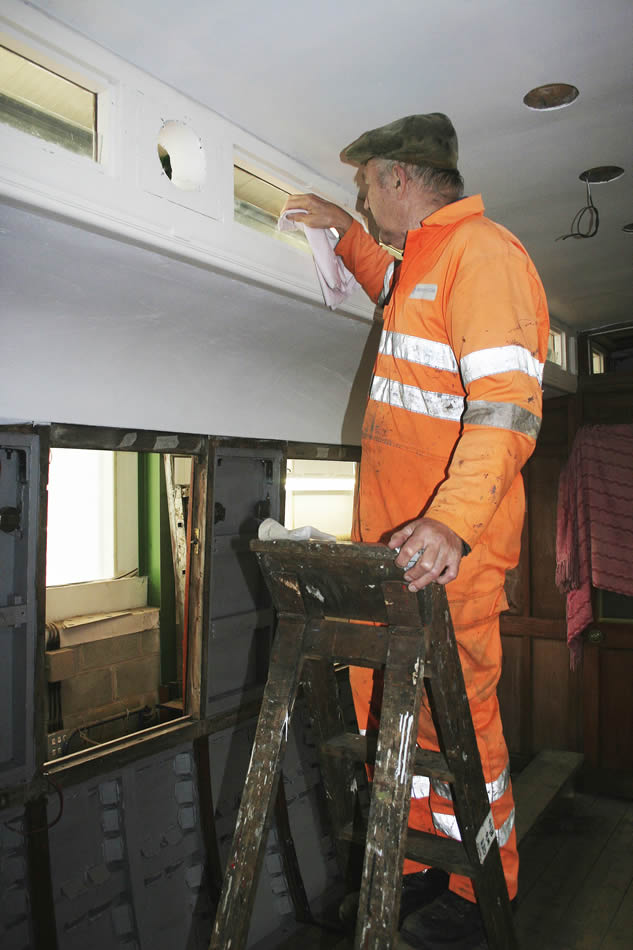
With new ceilings in place, Mick Watson polishes the clerestory
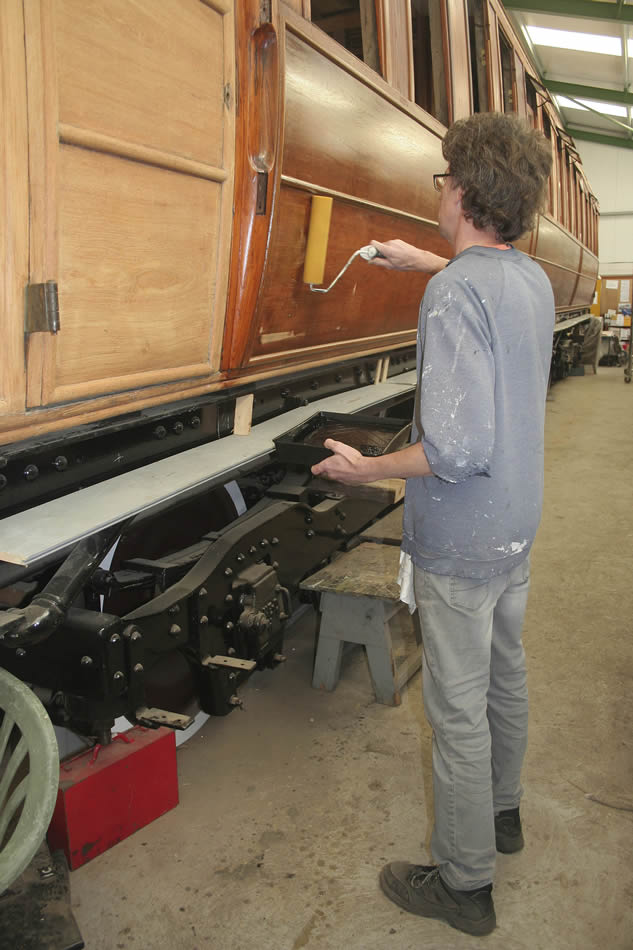
The first coat of varnish goes on No. 189. Russ Whitwam wields the roller. Photo: Murray Brown.
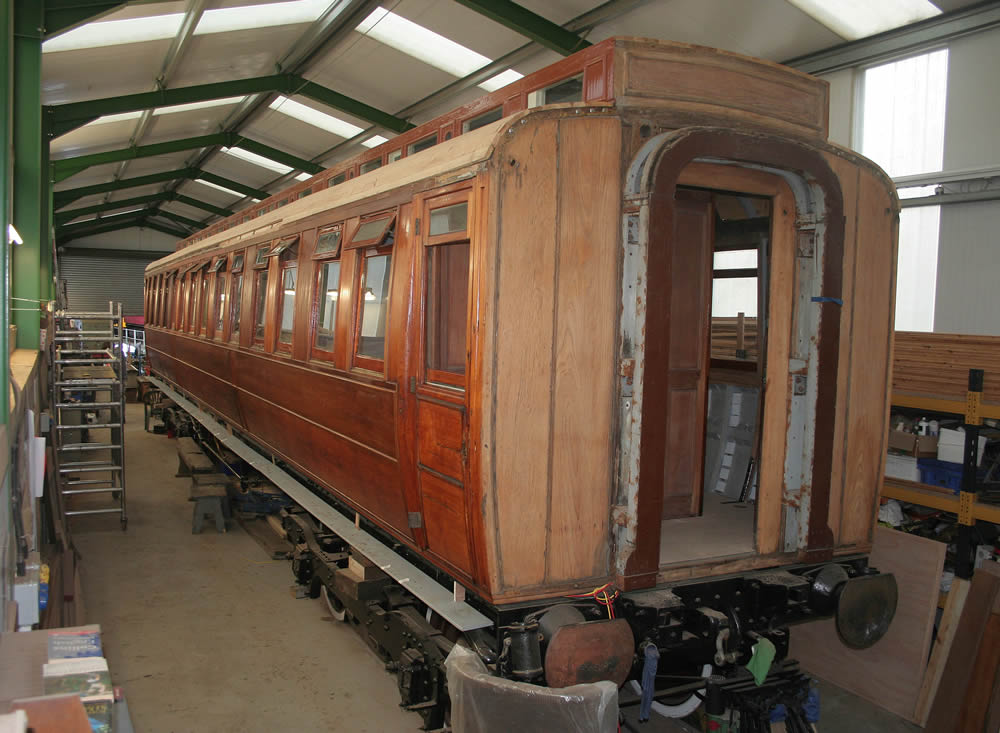
Looking good – the first coat of varnish transforms the west side of No. 189.
Photo: Murray Brown.
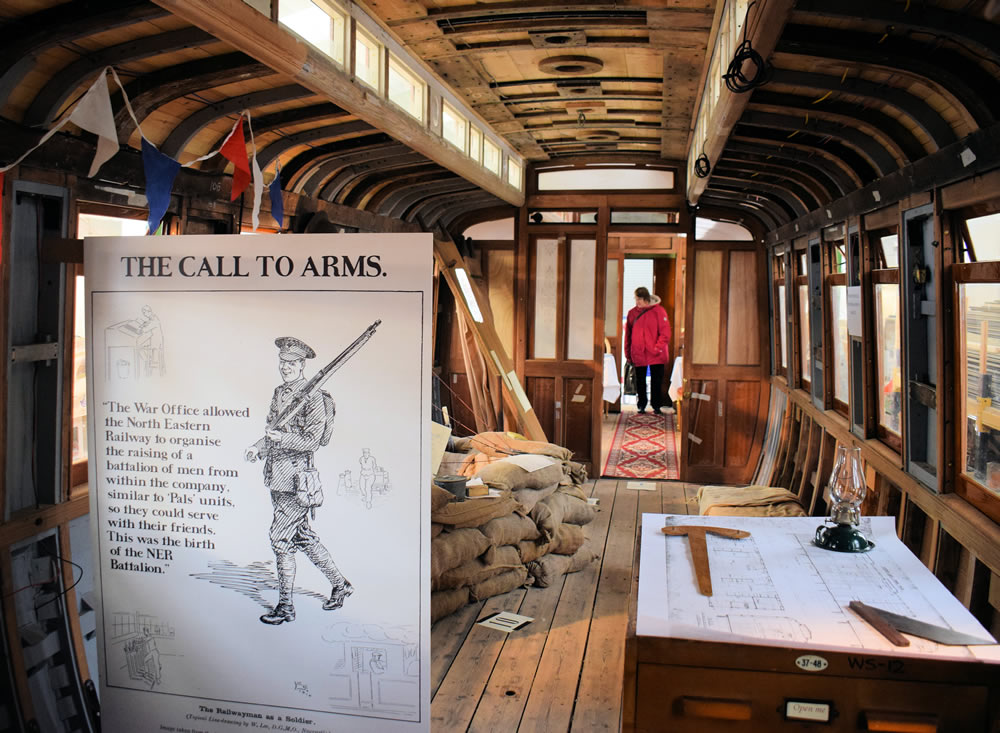
View of the exhibition – with the pantry behind the camera, this view shows the recreation of David Bain’s drawing office (the designer of No. 189) with, beyond, the WW1 scenario and, at the far end, the dining area. Photo: Rodney Towers.
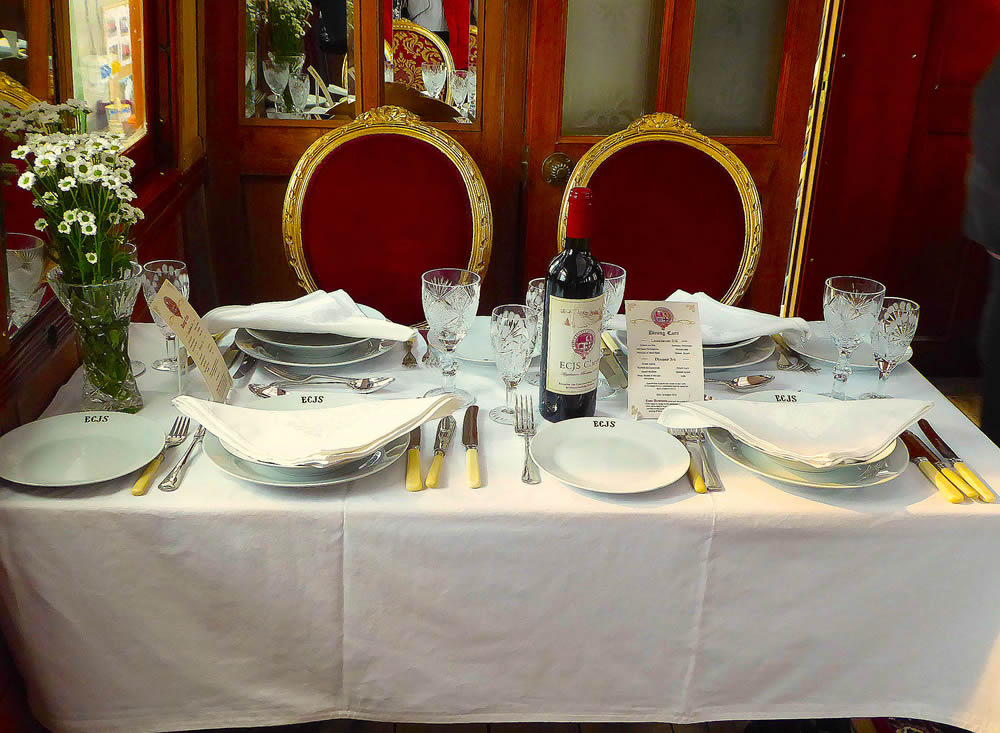
Table for two sir? The extraordinary transformation of what was only two weeks earlier a skeletal bodyshell, No. 189 provides an insight into what it was like over 100 years ago – and a taste of things to come. A glass of ECJS Claret, madam? Photo: Mags Woodcock.
Teak panels start being fitted to ECJS No. 189 and The Institute of Railway Research passes No. 189 as fit to run on the NYMR – Sept 2018
Another major step forward with the restoration of No. 189 has been the fitting of the first teak panels to the bodyside. Prior to this, a huge amount of preparation work took place – both to the body framing and to the teak panels themselves.
The body elements comprised the half-pillars, the vertical wooden sections over which the panels are fitted. These were sanded down, especially their sides where the glue blocks would be attached.
Several of the long teak panels had splits which required mending, some as long as 8ft. To repair a split panel, the end of the split is drilled and plugged with a teak ‘bung’ in order to stop the split propagating. Using the superb ‘West’ glue, the crack is carefully widened and the glue applied to within the crack itself. Then, clamps are fitted and tightened with considerable force and left for 24 hours to enable to glue to set. Then the panel is sanded. No sign of the former crack can be seen.
Once the panel has been lifted into place, it is pinned along the bottom using copper pins (to stop corrosion). Clamps hold the panel in place whilst glue blocks, triangular pieces of wood about 3” tall, are fitted on the inside of the panel. One side of the block is glued to the panel itself, whilst the other side of the block is glued to the vertical half-pillar. This is why the faces of the half-pillars must not be painted, but left bare so that the glue is not trying to stick to painted wood – a recipe for failure.
Once the glue has set, the entire inside panel and glue blocks are painted with aluminium primer.
Meanwhile, many man-hours have been spent sanding down hundreds of components for the inside of the carriage in preparation for the many coats of varnish.
Other work progressing has been the fitting of the wooden stringers. These are curved pieces of wood which are screwed to the roof planks. Once in place, the plywood ceiling panels can be fitted, the ceilings being screwed into place by means of the aforementioned stringers.
Underneath the carriage, far from view, are large runs of wires, all carefully secured in place on the underside of the floorboards. Whilst 189 was originally gas lit, one improvement on yesteryear will be LED lights – at least passengers will in future be able to see what they are eating.
All this work being undertaken by every volunteer who ventures into the Atkins shed is all for one thing – to have No. 189 ready for the exhibition ‘From Speed, Steam and Sumptuous Dining to Tracks into the Trenches’, due to be staged at the NYMR’s Wartime Weekend on October 12th-14th. Whilst the carriage will not be fully restored, it is intended to have sections in it representing what it was like in its heyday through to the present rebuild, during which visitors will be able to enjoy an audio visual presentation. The LNERCA’s press release is shown below:
PRESS RELEASE
Visitors to the North Yorkshire Moors Railway’s Wartime Weekend on October 12th-14th will be able to enjoy an additional attraction – to look inside a genuine Victorian Restaurant Car and partake in an audio-visual presentation – ‘From Steam, Speed and Sumptuous Dining to Tracks into the Trenches’
The Exhibition will tell the story of the Third Class Dining Car, East Joint Joint Stock No. 189, and give a glimpse of how the restoration will bring it alive in all its Victorian/Edwardian glory. Set in a WWI context (as part of the NYMR Wartime Weekend) it will merge the factual story with the fictional tale of Sam ’Nipper’ Perkins, former pantry boy, steward and latterly WWI soldier, together with true stories from the NER battalion.
Visitors will don headsets containing Sam’s narration of the ECJS 189 story, woven with his own WWI story which will take them on a journey through the coach. The Restaurant Car will be divided into sections containing a mock-up of the carriage designer’s office (David Bain), the Pantry, the actual ’bare bones’ framework undergoing restoration, a WWI scenario and a mock-up of dining tables set for a sumptuous meal. Projected images or large photos will help bring the story to life and create an immersive experience. When fully restored, this vehicle will be the only extant ECJS carriage in which the public will be able to travel.
No. 189 has an incredible, long-lived history, ranging from Victorian and Edwardian opulence to a pig farm and rebirth from what amounted to a forlorn wreck.
No. 189 last carried passengers in 1927 after which the carriage body was sold to a Holme-on-Spalding-Moor pig farmer. There it languished for some 60 years before a preservationist secured it in the 1980s, mounting it on an old underframe recovered from a burnt out carriage. Since 2010, the LNER Coach Association has owned it and has been undergoing an extensive restoration.
It has eight restored carriages ranging from 1909 to 1950, these being in regular use between Pickering and Grosmont. They have appeared in numerous films including, recently, the remake of ‘Dad’s Army’ and ’Downton Abbey’.
For more details of the LNERCA and the Exhibition – contact Nick Stringer on 01423 340331.
Finally, regarding No. 189, the LNERCA heard on September 6 that this historic dining carriage had passed the stringent examination to declare it fit to run on the NYMR. Because a replacement underframe has been used for No. 189 which has necessitated shortening and modifying it for its new purpose, it was necessary to seek external independent expertise to sanction its use.
To satisfy the requirements of the NYMR’s safety management system it is necessary for the design and manufacture of these modifications to be independently reviewed by a ‘competent person’. The LNERCA engaged the Institute of Railway Research (IRR) at the University of Huddersfield to carry out this review. No. 189 has now passed the IRR’s exhaustive review.
CCT E1308
Work has temporarily stopped on renovating the CCT to enable all resources to be directed towards making No. 189 ready for the exhibition to be staged therein on October 12th-14th
Fish Van E 75169
No further progress to report apart from the kind offer of the Pickering Wagon Group to assemble the brake cylinder with new components.
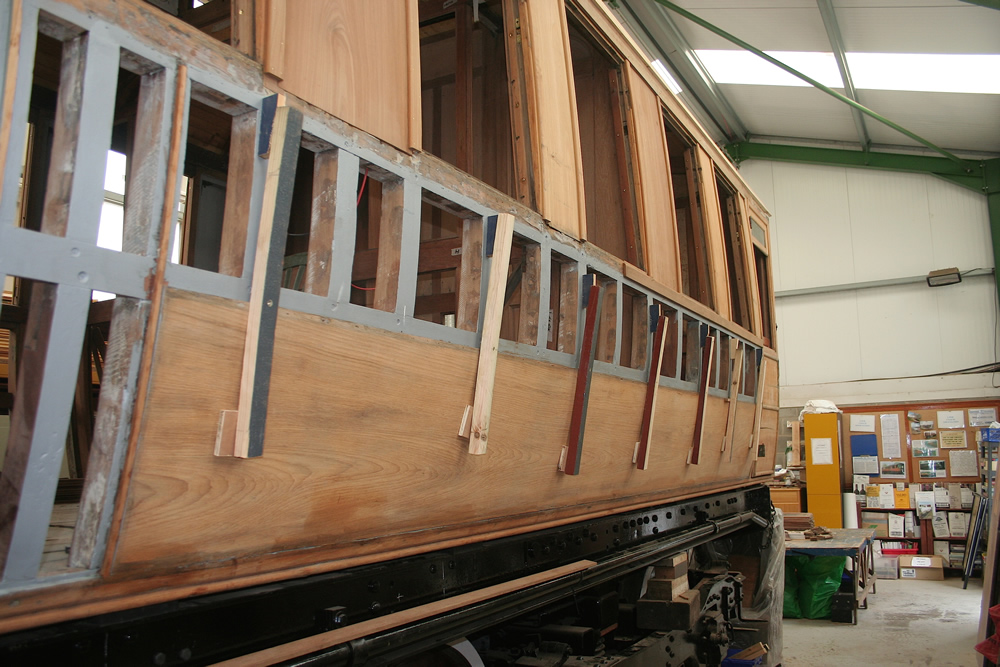
The first teak panel is fitted. Using copper pins, which are less prone to corroding, along the bottom and top, the panel is held in place by the batons using a screw into the waist rail half way up each baton. On the inside of the teak panel, glue blocks are applied, each one of which is glued to the half-pillar and to the rear of the panel – see later picture.
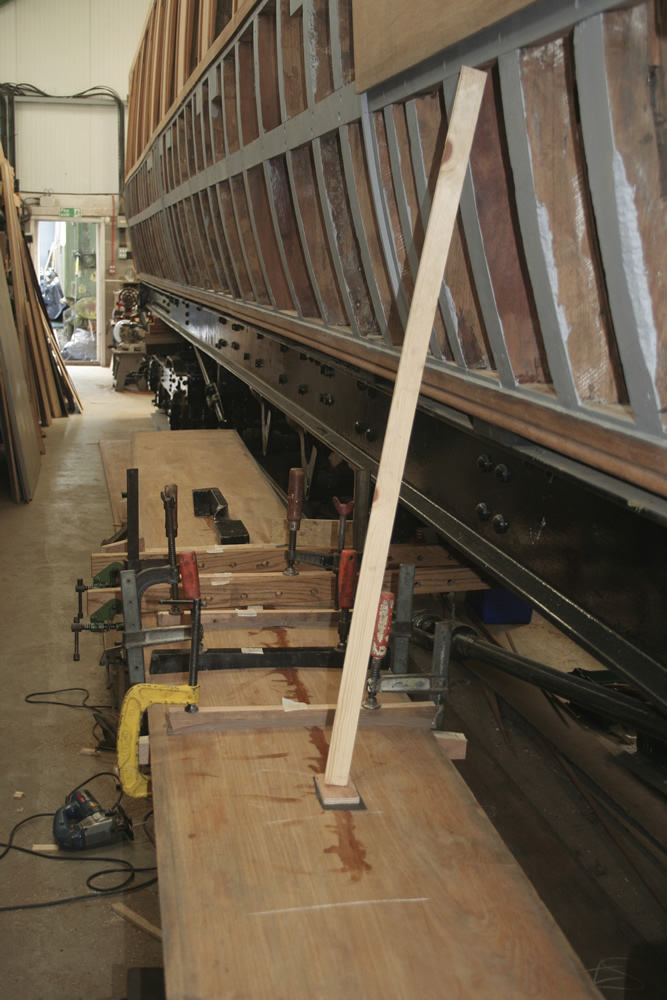
One of the split panels receives attention to a large crack, some 8ft long. The very end of the crack is plugged after drilling a hole at the end of the split and using a round piece of teak. The crack itself is filled with ‘West’ glue and then clamped. Because the panel is slightly bowed, the wooden baton jammed against the framing and the panel itself helps keep the split tightly closed whilst the glue sets.
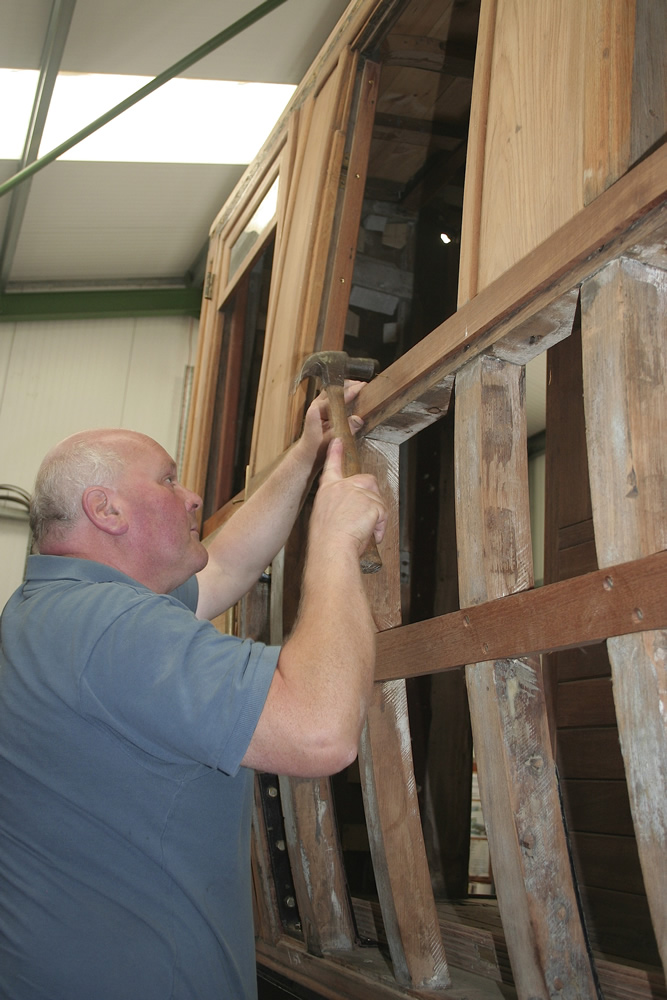
A piece of teak runs along the entire length of the carriage – this is known as the waist rail. Marcus Woodcock fits the new waist rail in position by means of copper pins. Several sections of waist rail are used, each one butting up to its previous one fitted. The entire waist rail must be level otherwise the finished product would look dreadful.
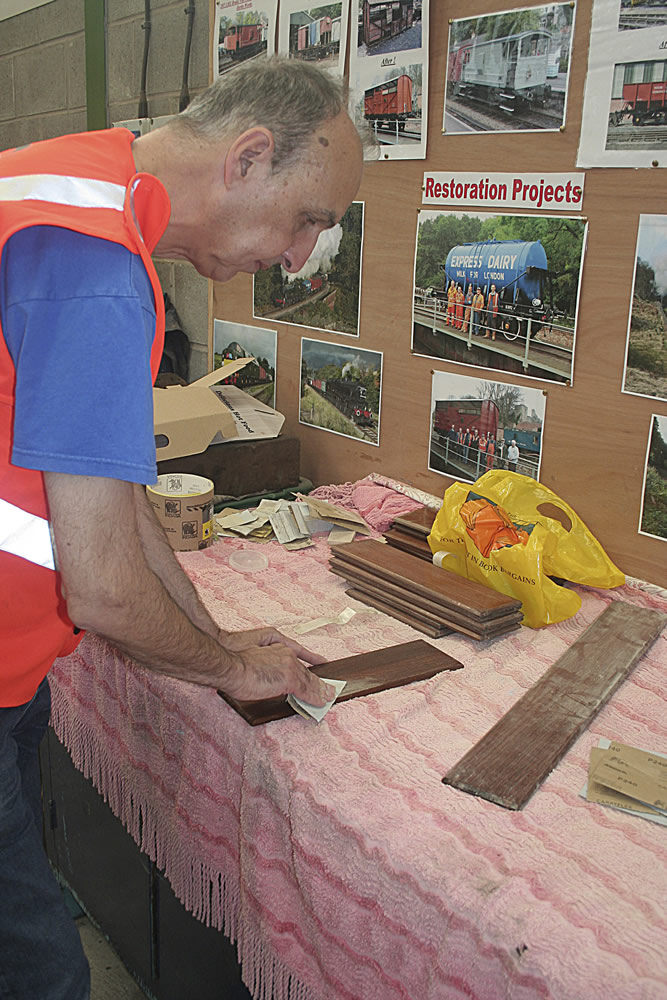
It has to be done. One of the less glamorous tasks is the sanding of scores of pieces of teak used for the interior fittings. These include the panels and the window frames. Here, David Young prepares some of the smaller pieces preparatory to the varnishing starting.
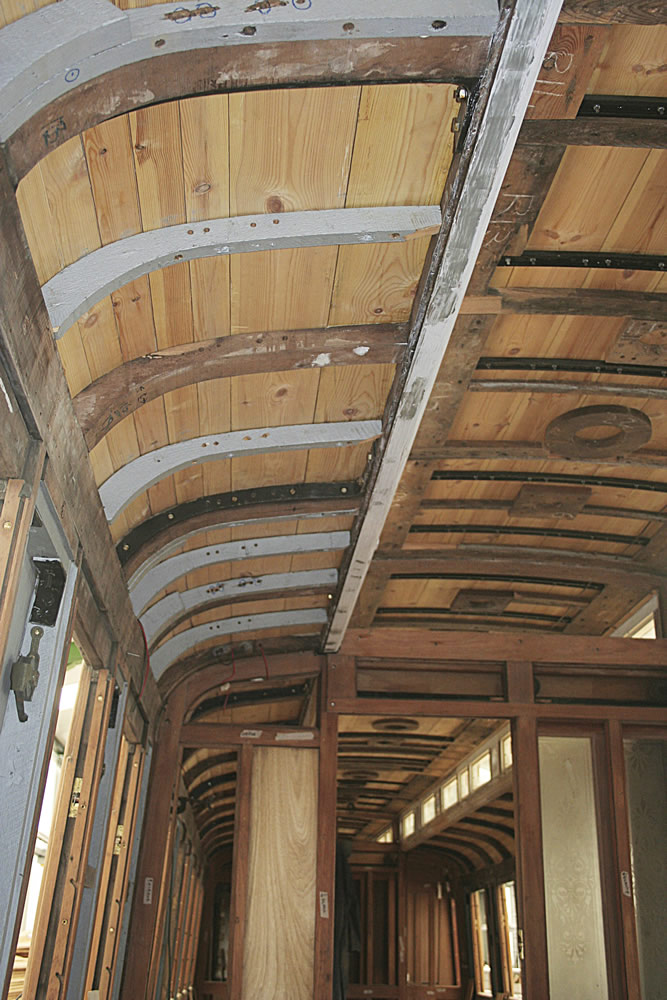
Inside, work continues to prepare for the ceiling panels to be fitted. These panels have to be secured in place and to do this, wooden stringers – seen in the picture painted grey – are screwed into the roof boards. The plywood ceiling panels can then be screwed into place.
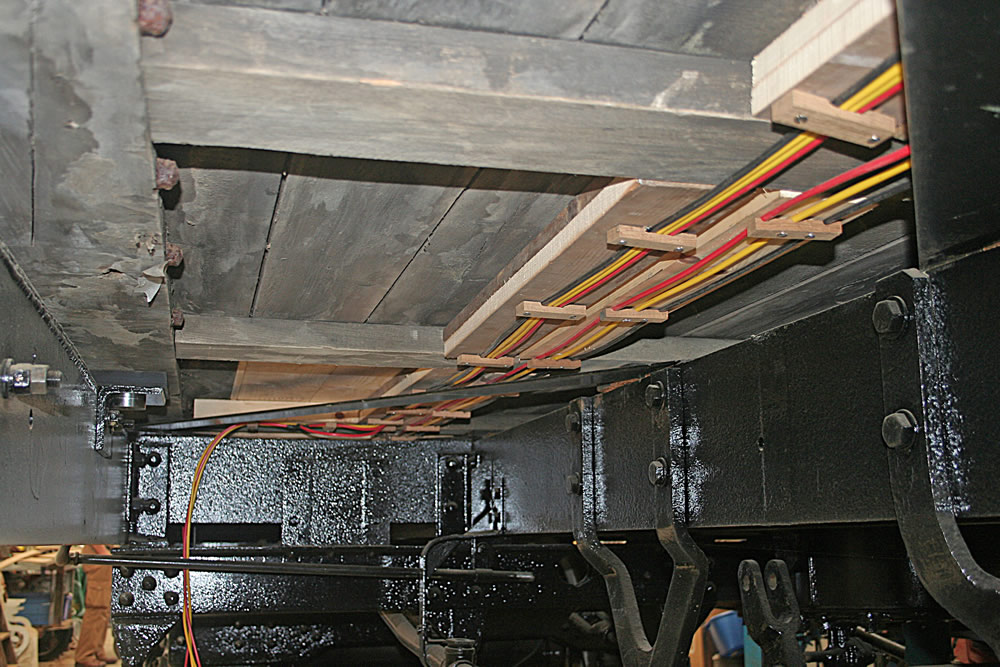
Already, a vast amount of wiring has been installed out of sight by Gordon Wells. Much of this is underneath the floorboards. The internal wiring has to be fitted prior to the ceiling panels being screwed into place. The wiring runs above the ceiling, through holes in the stringers. LED lights are being used in replica gasoliers which will offer a far brighter illumination than the original gas lights.
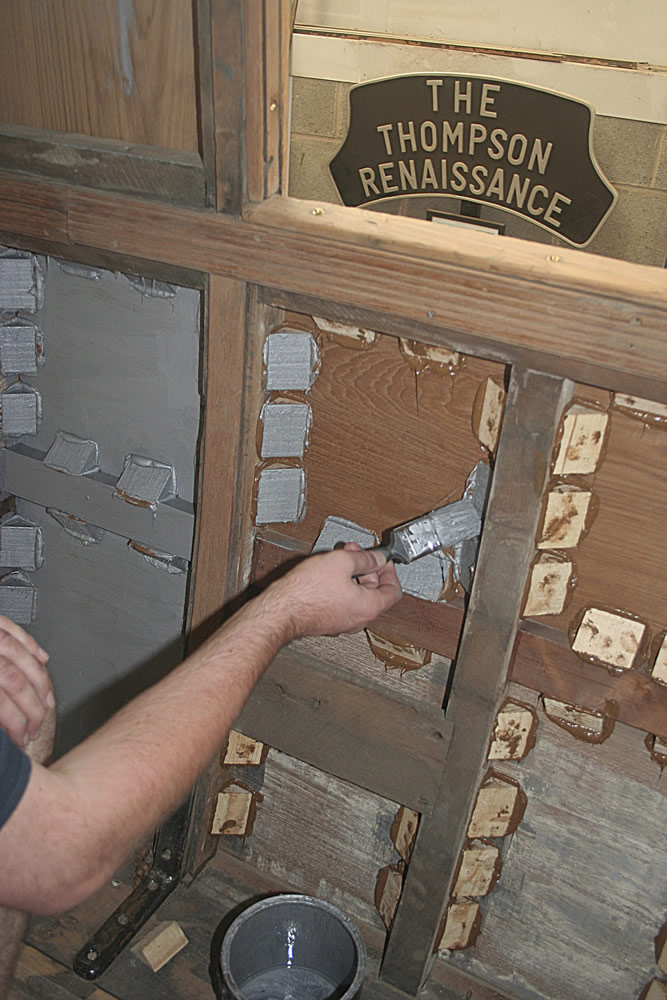
Once a teak panel has been secured to the framing and the glue blocks have set, the entire inside – panel and glue blocks – can be painted in aluminium primer. This painting helps keep out moisture and possible water damage. This image shows how the glue block adheres to both the half-pillar and the rear of the teak panel. The phantom hand belongs to Gary Lyne.
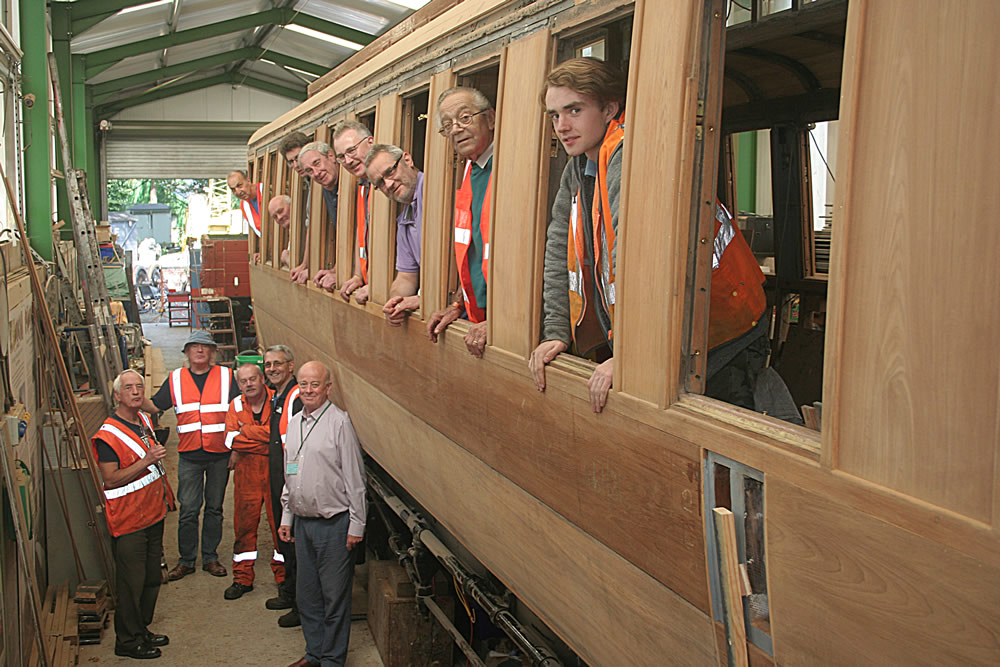
Take a bow. Some of the many volunteers who have transformed this woebegone relic into what it is today – well on the way to being finished. With one side completely repanelled, No. 189 is beginning to resemble a carriage once again.
The only way is down – 189’s body is finally lowered all the way onto its underframe – Aug 2018
It only took just over an hour to roll East Coast Joint Stock No. 189’s body off its underframe of nearly 30 years onto its newly modified one, but it has taken weeks since then to actually lower the body so that it sat evenly on its underframe and bogies.
The final lowering took place on Thursday July 19th. Not only were there delays in supplying the special bolts but it then took several weeks to drill the holes through the bottom rail and the new solebars and rubber pads in order to allow body and underframe to be bolted together. When all the bolts were in situ (but not tightened), the body was jacked up very slightly to allow the removal of the wooden blocks, separating the body from the underframe. The wood packings were removed bit by bit as it was thought that if one end of the carriage was lowered in one go, it might jam the bolts at the other end of the carriage. Once the entire body was flat against the underframe, cushioned by the rubber pads, the bolts were then tightened. Job done at last.
Inside, many of the window frames have been prepared for varnishing. Several poor quality floor boards have been replaced and the partition walls for the pantry have been trial fitted.
The next aspect of 189’s restoration is to fit the external teak panels – this will begin to hide the skeletal frame which has greeted visitors to the Atkins shed for several years. There is now to be a major push so that the planned exhibition which includes an audio visual display can take place at the 1940s Weekend in October.
Covered Carriage Truck No. 1308
It is good to report that much of the west side of this 1950-built CCT now has new panels and new doors. By the end of July, the last panel was receiving attention, the internal framing of this section of the vehiclke being in somewhat poor condition, necessitating various new support members. Once these are finished and painted, the new tongue & groove panels will be installed, primed and top coated in LNER Brown. The new doors are fabricated inside the Atkins shed, this necessitating numerous mortice & tenon joints. All the metalwork from the derelict door is removed and totally refurbished before being bolted onto the brand new sliding door. The plan is once the west side is completed, No. 1308 will be turned so that the restored side is facing the trains – and the public.
We are taking ‘artistic licence’ with No. 1308. Being built in the British Railways era, it would have emerged new in maroon. However, as the type made its debut in 1939 (the second batch from 1950 was identical) we are painting No. 1308 in the colour had it been built in 1939.
Fish Van E 75169
The first application of the top gloss white paint is now being applied to the stanchions.
The scorching heat some days in July did not make for good painting conditions as the paint became tacky almost immediately.
A replacement brake cylinder piston has been procured, thanks to Ian Broadhead of the Pickering Wagon Group. This means the brake cylinder can now be assembled with new components and fitted to the underframe.
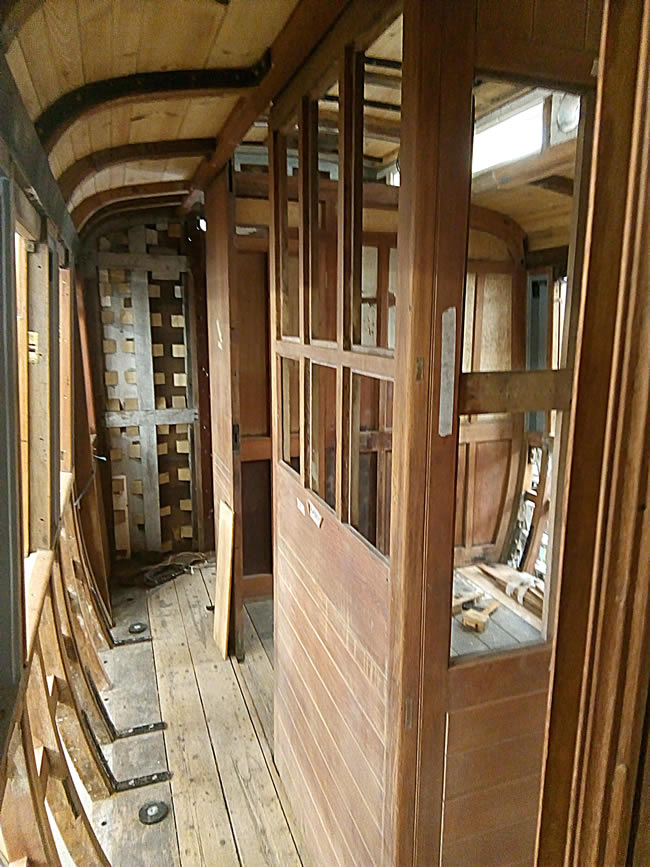
No longer can anyone walk the length of the carriage – as was the case when it was built in 1894 – because the pantry walls have been trial fitted. This is the view showing the corridor past the pantry. Photo: Marcus Woodcock.
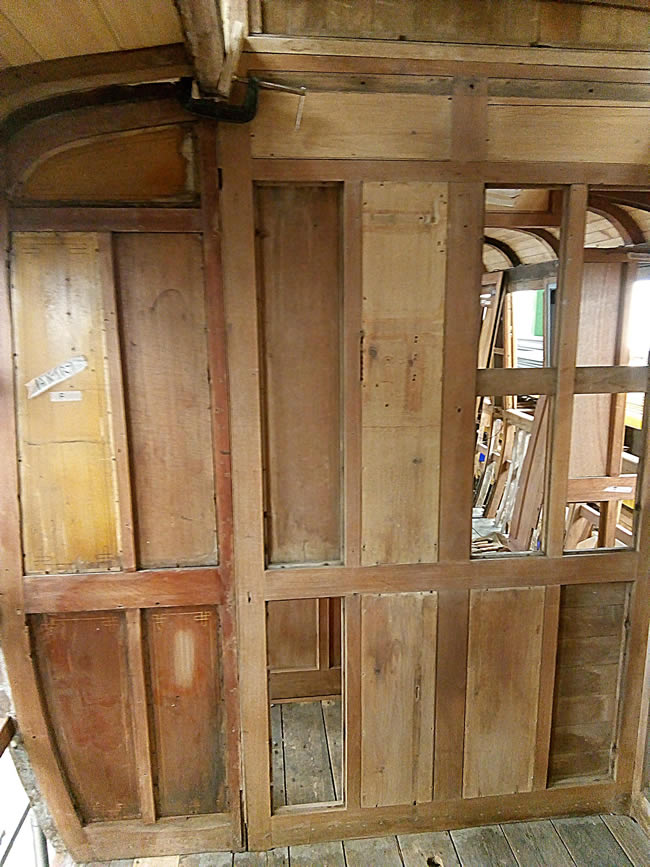
The pantry was installed in 1909, thus reducing the number of seats. When the carriage is fully restored, this pantry will be an exhibition area and not used as per original function. Photo: Marcus Woodcock.
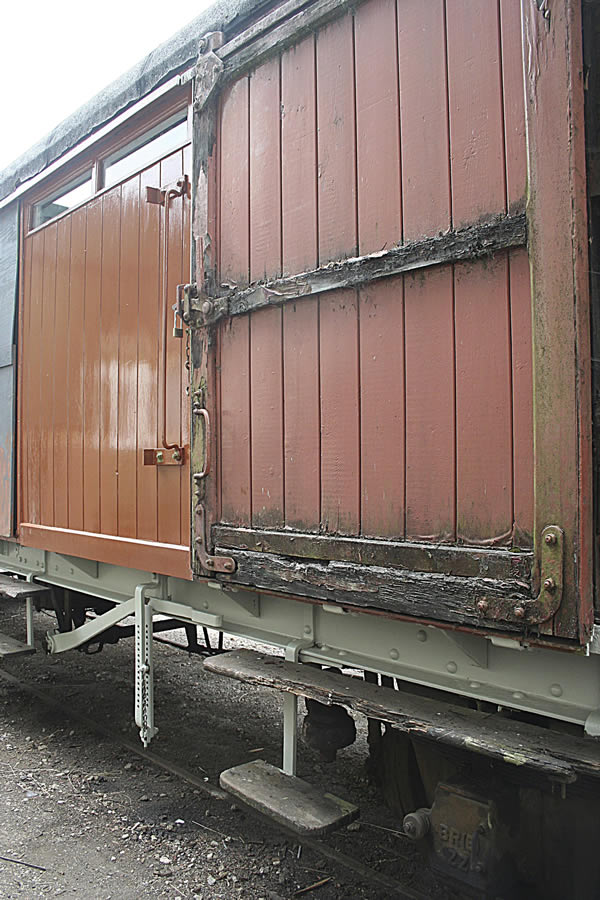
The stark contrast between the derelict original and the brand new door can be seen in this view. The 68-year old CCT is a most valuable resource in terms of being a storage facility. Photo: Murray Brown.
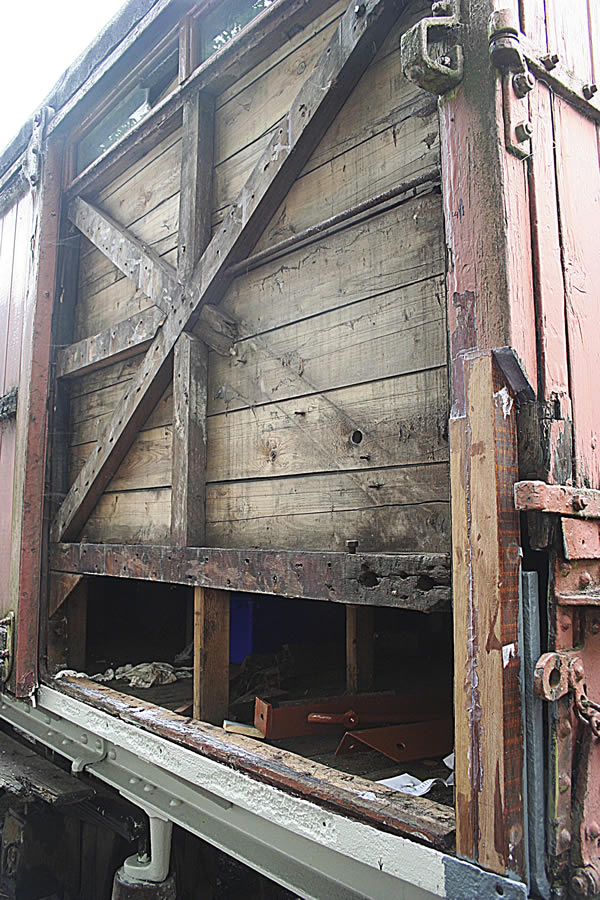
On the CCT, this is what the restorers are having to repair prior to the external tongue & groove panelling being fitted. Where the framing has reached the end of its days, it is being replaced. Photo: Murray Brown.
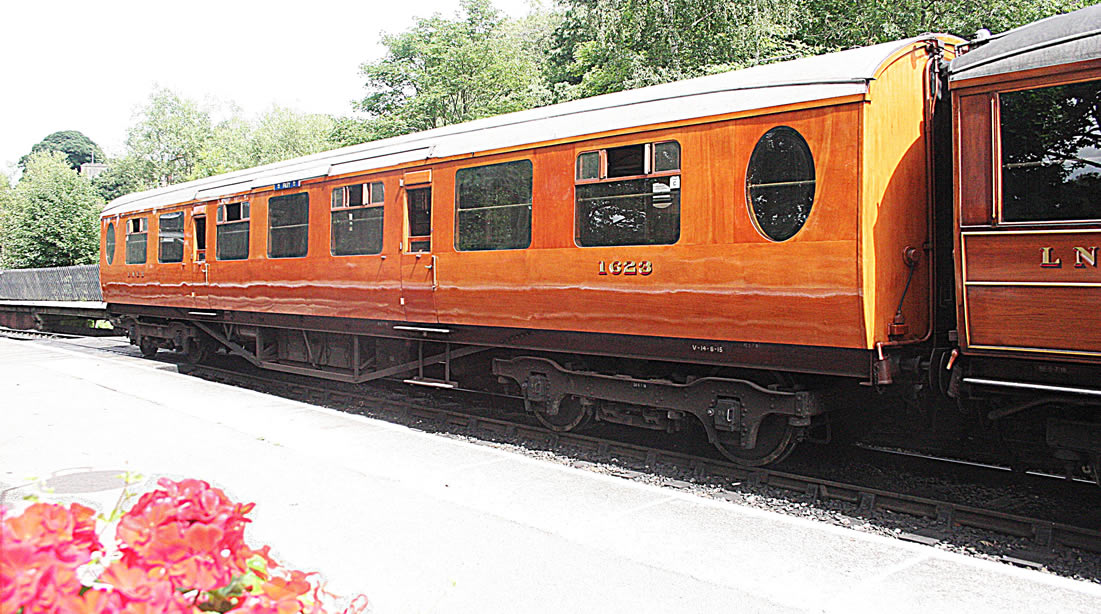
The Thompson-designed Third Corridor (TK) No. 1623 has stood up well so far to the NYMR climate in the two years it has been in service. It was felt that if it had a revarnish, this would tide it over for two or three more years and so prevent an enormous amount of time out of traffic being repainted in scumbled teak. C&W painter, Mark Toyne revarnished No. 1623 in July and this is the gleaming result. Mark is renowned for the quality of his hand-painted carriages. Photo: Murray Brown.
It’s not just the Lottery which has Roll Overs! – June 2018
The LNERCA finally moves the body of No. 189 onto its new underframe.
Photographs by Murray Brown unless stated.
After some two years hard work and considerable planning, the long-awaited ‘roll over’ of the body of East Coast Joint Stock Restaurant Third No. 189 onto its permanent underframe has taken place. It was moved from its ‘wrong’ underframe onto the newly modified one. This took place in the Atkins shed on Thursday May 24, over two days later than planned.
Just to recap, when the derelict body of ECJS Restaurant Third No. 189 was salvaged from the pig farm at Holme on Spalding Moor in the 1980s, it was placed on an underframe recovered from a burnt-out non-corridor Gresley carriage which had been set on fire by vandals at Immingham depot. Because the underframe was too short, large timber baulks were added to the ends behind the buffers. The LNERCA had a spare 61’6” underframe, so decided to have it shortened to the requisite length and to have a new solebar (top beam) welded on to replace the corroded original.
For the body move to take place, an enormous amount of work had to be undertaken. To summarise, this entailed:
- Clearing the huge amount of stored materials from the floor of the Atkins shed.
- Unloading the ‘new’ underframe from the lorry at New Bridge (it had arrived from Shildon where modifications had been effected) and moving it to Pickering yard – this was kindly undertaken by Kieran Murray, C&W Manager.
- Moving the Pickering Wagon Group’s Pipefit wagon out of the way to enable No. 189 to be shunted out – this was then taken by the C&W Manager down the Long Siding out of the way temporarily.
- The newly modified underframe was shunted onto the turntable, turned and then slowly moved into the Atkins shed at the south end of the shed where the line is straight (the line at the north end of the shed is on a slight curve).
- No. 189 was retrieved from the Long Siding and shunted into the Atkins shed, buffering up to its intended ‘new’ underframe.
- Considerable effort was then made to ensure both vehicles were level so that the body could move easily from one underframe to the other. Strips of plywood were fastended to the solebar which would allow the rollers free movement.
- NELPG had kindly made available discarded boiler tubes from the Q6 which had been cut into 9ft lengths – these had been collected from Grosmont shed and were then placed under the body of 189 which was sitting a few inches off its underframe to allow space to place the boiler tubes at specific intervals.
- Using a turfer – ratchet mechanism – with added 5-ton strength nylon rope attached, the pulling wire/rope was attached to the rear of the 189 to winch the body forward. Another rope was attached to the rear of No. 189’s body, the other end of which was wrapped round the coupling hook of 189’s old underframe so that when the coach body began to move, it offered a safety device to stop any potential runaway incidents – this was considered highly unlikely. Thus the brakeman, Andy Cox, fed out the rope from the rear as the body moved away, being able to quickly slip it round the coupling to stop any movement should the need arise.
- The body weighs near enough 5 tons and moved surprisingly easily. Frequent stops were made to ensure the rollers did not snag on obstructions such as protruding bolts.
- Once a roller became exposed as the body moved forward, it was carried to the front and placed on the new underframe, so helping take the weight as the body slowly moved onto it.
- Volunteer, Mike Faulkner stood at the south end of the shed assessing how the body was moving towards him in terms of lateral position. Occasionally it was necessary to tilt the rollers away from right angled to the body – this allowed the body to gradually change direction slightly to one side. Once the move had been completed, at the south end, the body was 1/8th inch out. At the north end it was 2” out. To correct this, the body was jacked and rollers placed parallel to the body which allowed 189’s structure to be nudged sideways to the correct alignment.
The move took one hour, fifteen minutes.
All in all, a magnificent job. Top marks to Marcus Woodcock and all the volunteers who helped. We also thank Eddie Knorn for producing the ’Method Statement’ and C&W Manager, Kieran Murray and his Foreman, Ian Carney for assisting with all the shunting. We must also acknowledge the Severn Valley Railway who paved the way and showed us such a manoeuvre could be done as they successfully had their own ‘roll over’ with a Gresley Brake Guard (BG) body a few years back.
A few days later, with the body correctly aligned with the underframe, holes were drilled in the bottom rail of the body to allow securing bolts to be inserted, thus securing the body with its underframe.
And what of the displaced underframe? This was transported to Shildon on June 11 pending a storage location.
Finally, do have a look at the superb ‘speeded-up’ film of the whole event – this was masterminded by Gary Lyne and can be seen on YouTube by clicking on:
https://www.youtube.com/watch?v=pnSpQ6sFFC8
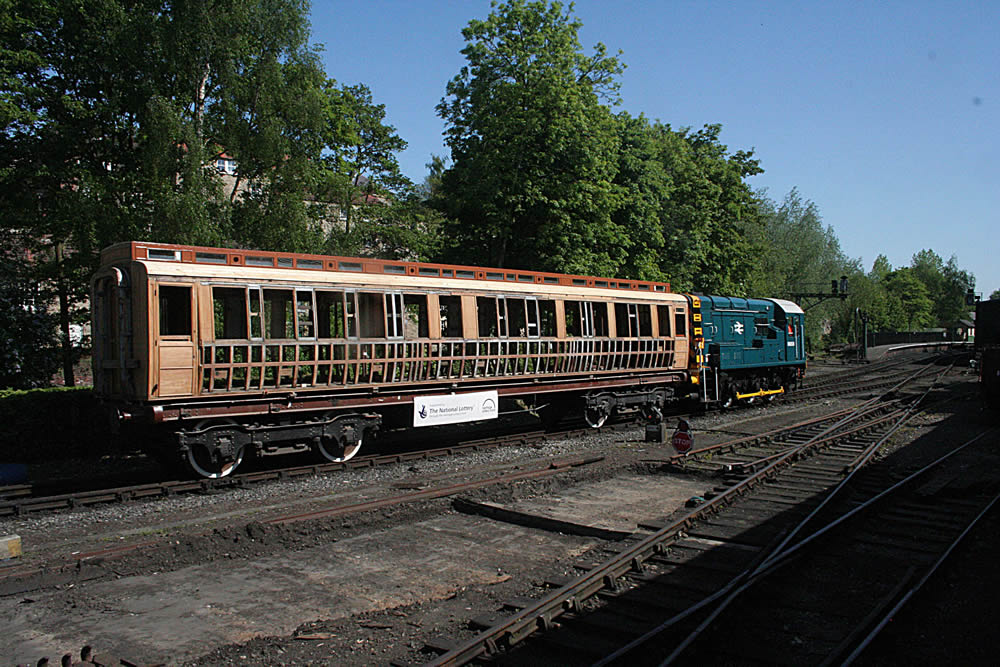
A rare view of No. 189 outside – seen being shunted to the Atkins shed where the body would be slid onto its new underframe.
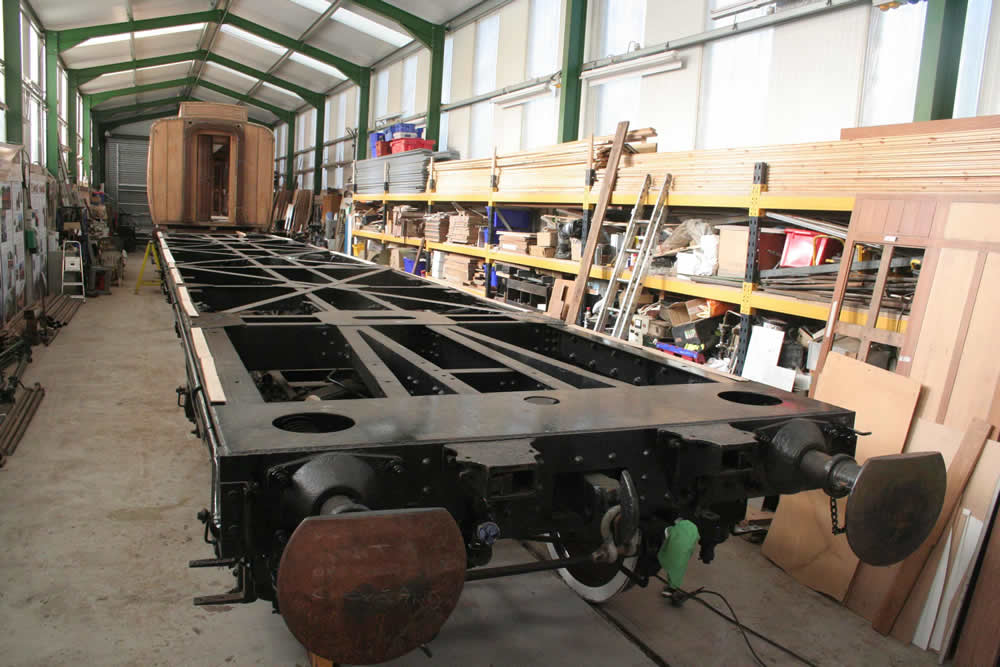
All ready – the ‘new’ underframe is in position at the south end of the Atkins shed ready to receive the body of No. 189.
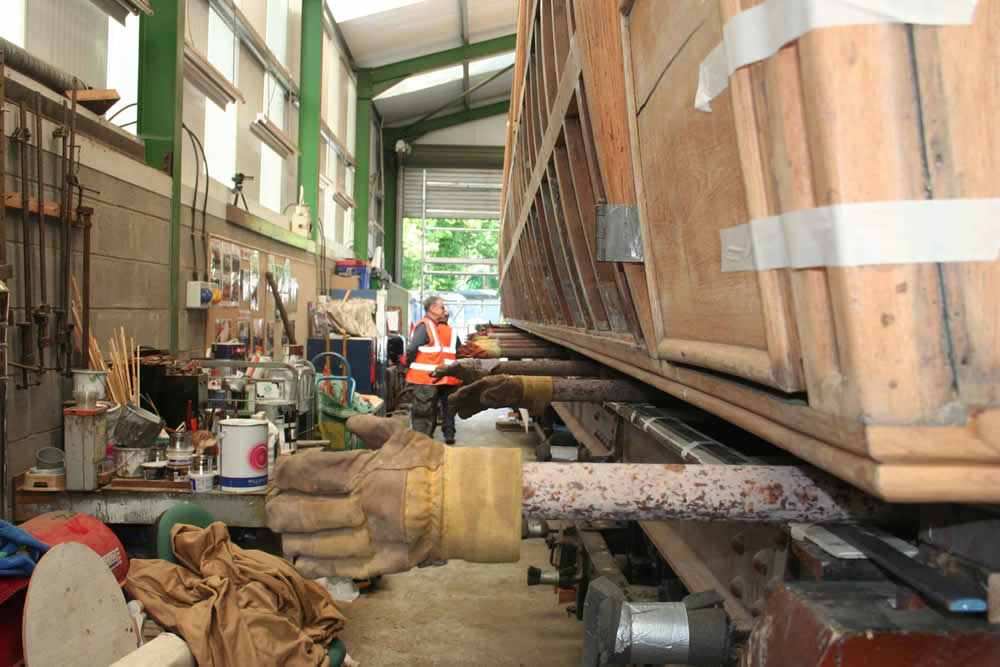
A close up showing the rollers (ex boiler tubes). The gloves were a visual safety measure. When the coach rolled, they waved!
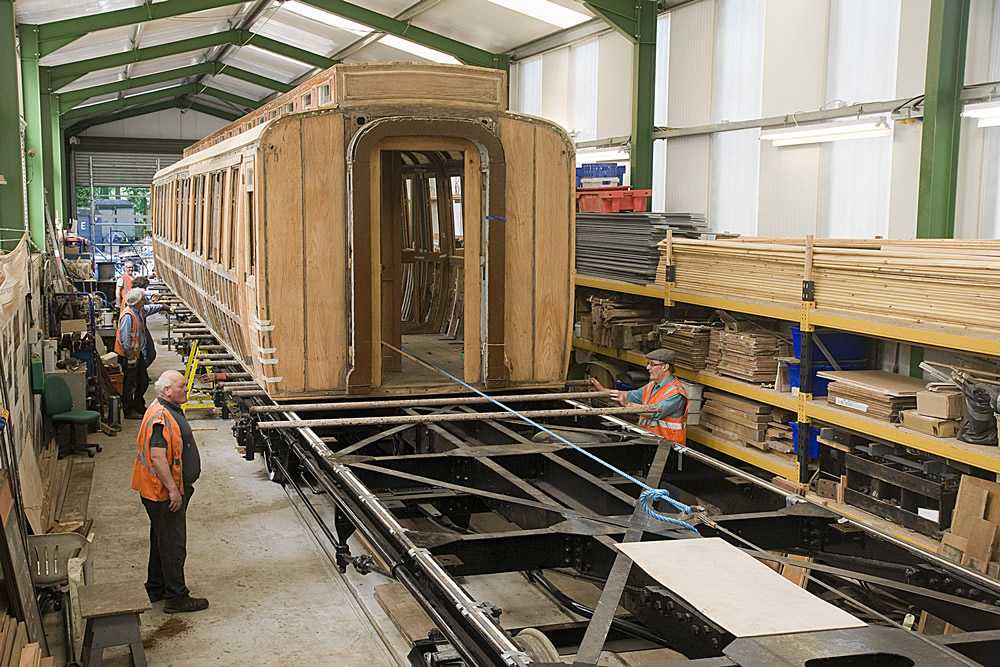
Displaced rollers are placed in front of the approaching body. At this stage No. 189 was sitting on eight wheelsets. (Photo.Gary Lyne)
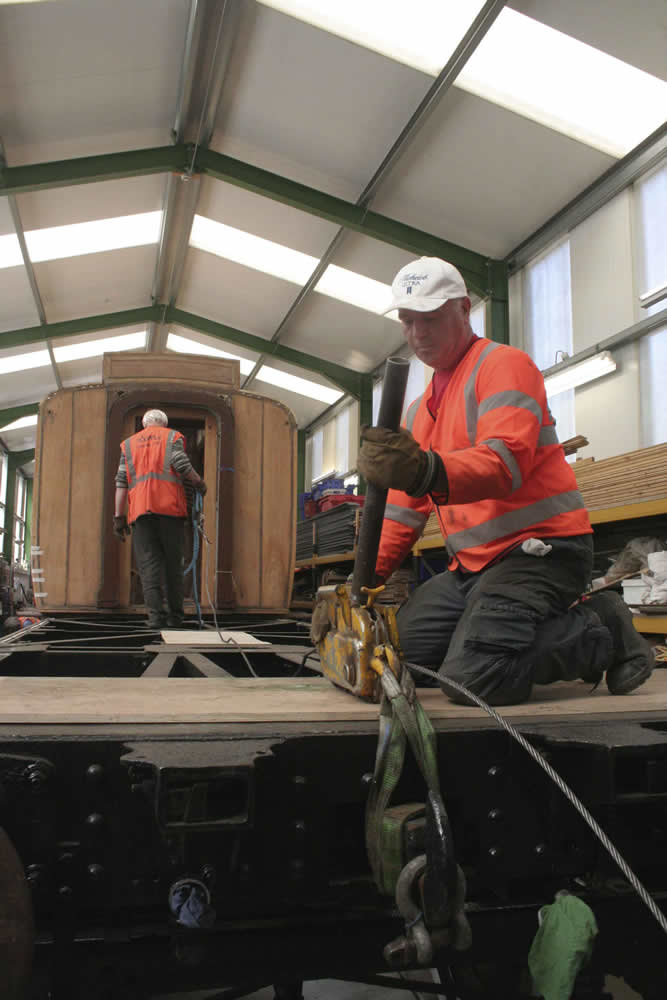
Russell Lifton was the designated Turfer – in charge of ratcheting the body forward in between shouts of “stop!”
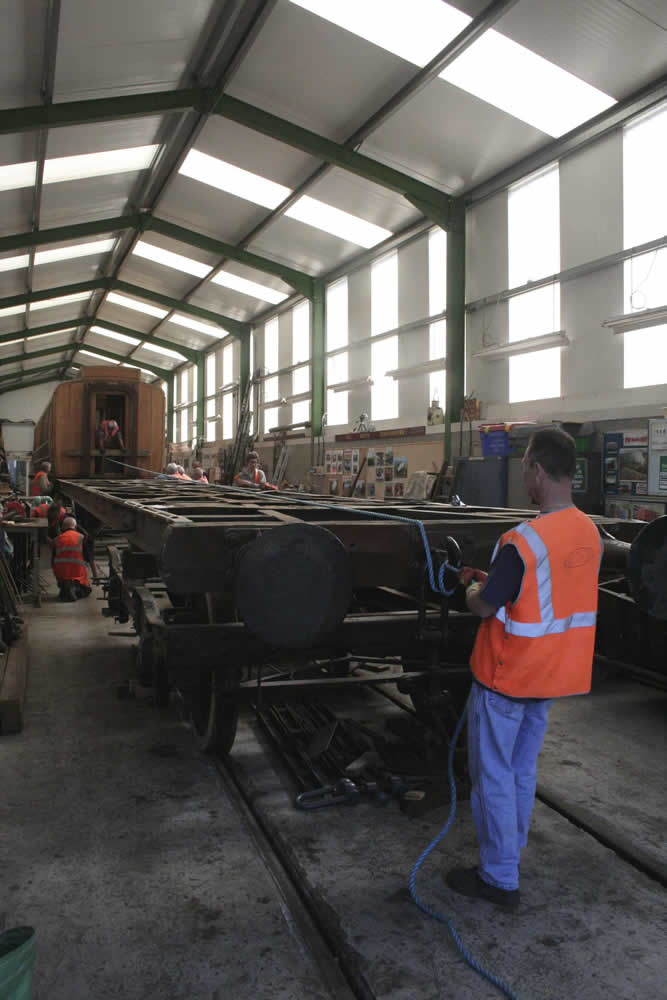
At the north end of the shed, Andy Cox was the brakeman, letting out the rope slowly as the coach inched forward.
Non Passenger Carrying vehicles in the spotlight
The bi-annual ‘Coach Week’ was held from May 5-13 and, most unusually, all the work centered round non-passenger carrying vehicles. Such vehicles play a vital role and are so often neglected on heritage railways even though they are part and parcel of railway history. This is even more relevant in today’s world when parcels and fish vans no longer ply their once common everyday life.
Our stores vehicle, CCT (Covered Carriage Truck) No. 1308 saw the first of the new doors, assembled, primed and hung, followed by undercoating and, finally, a top coat of LNER brown. This 1950-built CCT is at long last beginning to look rather smart as we work our way gradually round it replacing rotten panelling and fabricating new doors. A start was also made on derusting metalwork at the ends of the vehicle.
The plan is, when finished, E1308 will be parked in the isolated Beck Siding adjacent to the north end of platform 1. With it should go our former Gresley Restaurant Car 42969, now in use as the NYMR’s upholstery carriage workshop.
The other project which is also looking considerably different is our unique LNER Fish Van No. 75169. It has been a godsend that it is parked on its own bit of ‘track’ at the north end of Pickering yard where it is easily accessible with out impinging on C&W space or in the way of shunting.
All the framing is now gleaming black, the first coat, whilst all the vertical stanchions on both sides are now in white undercoat. Thus it has been visually transformed and is being looked at by hundreds of passing passengers.
In this respect, passengers can now see just what this skeletal vehicle is for Christopher Johnston has produced a white metallic notice emblazed with the words: ‘Last surviving LNER Fish Van 75169, Built 1949. LNER Coach Association’. Those with long memories might recall a similar sign on Thompson TK No. 1623 when it was in the open, long before the Atkins shed was built.
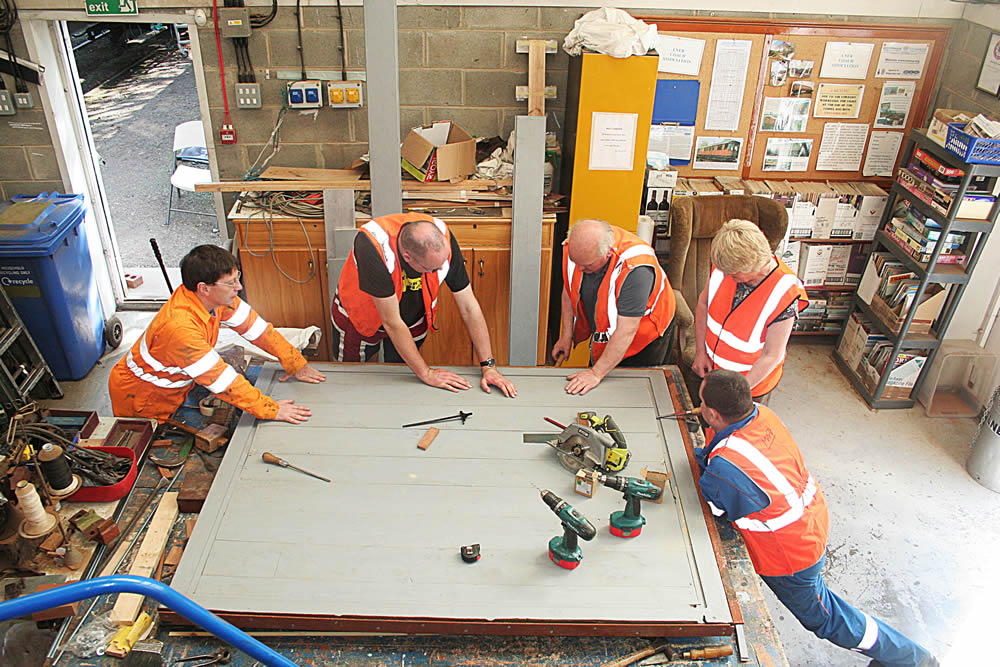
One of the new doors for the CCT takes shape on the workbench, prior to being lifted into place on No. 1308.
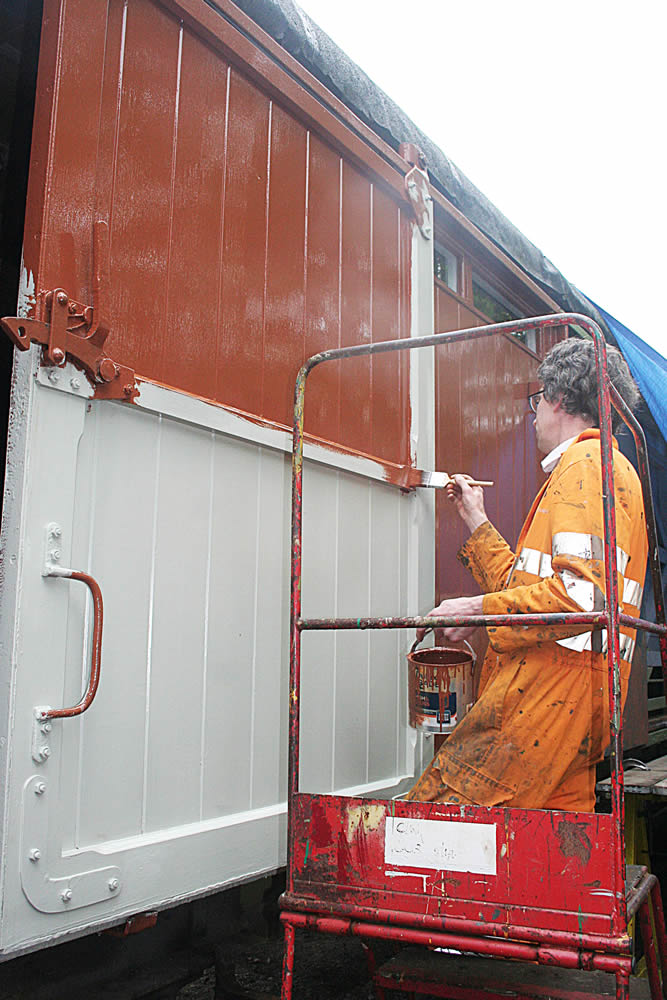
Russell Whitwam from Farnley, Leeds, wields the paintbrush, applying LNER Brown to the new door on 1308.
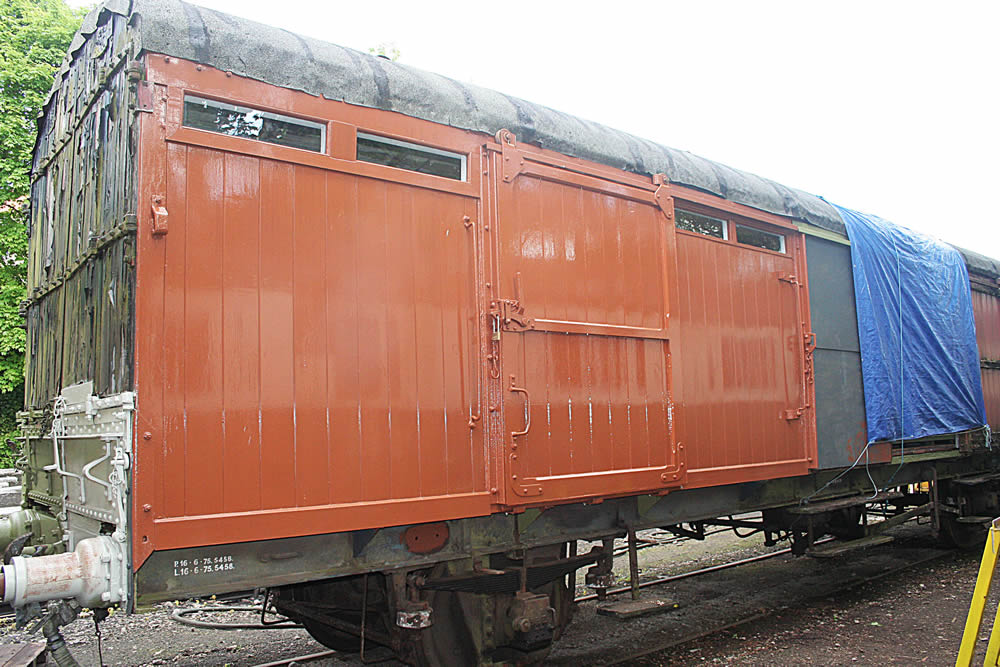
The CCT is looking infinitely improved, with several sections of paneling and new doors having been fitted and painted.
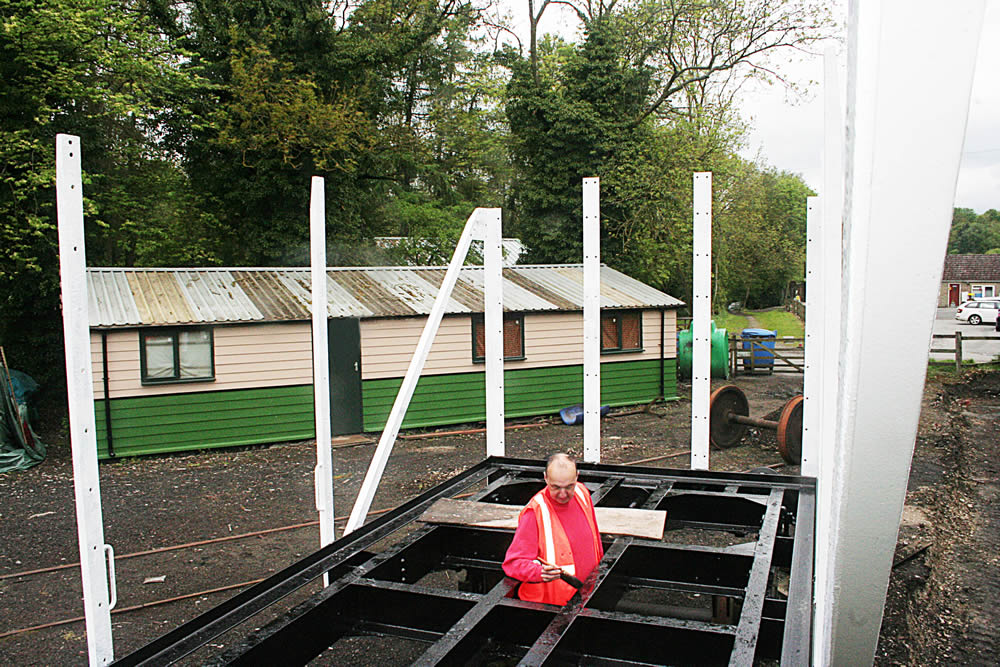
David Young from Staines helps apply the first top coat to Fish Van 75169’s underframe.
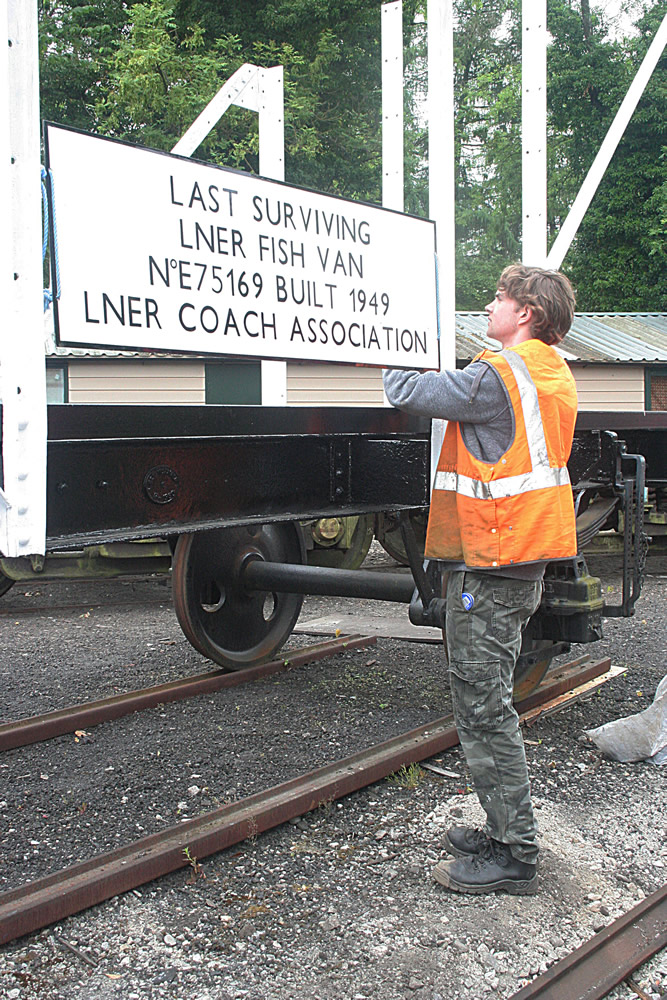
Passing passengers now know what is this skeletal wagon, thanks to Christopher Johnson who made this sign.
NER Luggage Composite No. 1111
A day was spent in May at Levisham fitting the drawhook to the south end of No. 1111 preparatory to it being towed at walking pace to New Bridge yard at the end of the season from where it will depart for Kirkby Stephen, Stainmore Railway. It is going on long-term loan and restoration is anticipated to start soon after arrival.
Annual General Meeting
The very letters AGM conjure up a scintillating way to spend two hours but it wasn’t too bad! Notable items to report were thanks given to Roger Melton for his work on the Newsletter and to co-founder and Treasurer John Hasler who received a round of applause. Both gentlemen will remain as trustees.
It was agreed unanimously to change the LNERCA into a Charitable Incorporated Organisation (CIO). This means it has a legal identity separate from its members and also offers the benefit of limited liability.
Youths sentenced for trashing our LNER rake:
After causing £27,000-worth of damage to the LNER set on July 23 last year, the eight youths were convicted and have been sentenced. The youths were charged with two offences.
These sentences were reported by the media as follows:
On 26 April 26 at Scarborough Magistrates’ Court Mollie Dawson (18) of Keld Head Orchard in Kirbymoorside was sentenced to a twelve month conditional discharge and ordered to pay fines and costs totalling £635.88 (this includes £530.88 in compensation). On the same day Benjamin Terry (19) of Jute Road in York was sentenced to a twelve month conditional discharge and ordered to pay fines and costs totalling £135.88 (this includes £30.88 in compensation).
On March 13 at Scarborough Magistrates’ Court a seventeen year old from Pickering was ordered to pay compensation of £530.88 and will have to complete a twelve month youth offending panel contract.
On March 27 at Scarborough Magistrates’ Court a 17-year-old girl from Pickering and a 17-year-old boy from Ampleforth, who cannot be named for legal reasons, were both ordered to pay compensation of £535.88 and will have to complete a twelve month youth offending panel contract.
On April 10 at Scarborough Magistrates’ Court a 17-year-old male from Malton was ordered to pay compensation of £535.88 and will have to complete a twelve month youth offending panel contract.
On March 13 at Scarborough Magistrates’ Court two 17-year-old boys from Pickering were sentenced to a youth offending panel contract for six months and will have to pay fines & costs totalling £135.88 each.
Two of the carriages – Buffet Car (RB) No. 641 and Thompson TK No. 1623 – are still not repaired, the former unlikely to be returned to service until 2019. Most of the compartment shoulder lights in No. 1623 were smashed to pieces and are having to be remade specially. This was the hardest and longest aspect of the entire restoration of No. 1623 when first restored.
Some of those responsible were given Referral Orders. This is a process whereby the young offender is referred to a youth offender panel. The young offender is invited to agree with the panel a contract which should include two core elements:
- reparation/restoration to the victim or wider community; and
- a programme of interventions/activities to address reoffending risk.
New roof boards go on No. 189 – and the Fish Van underframe changes colour! – April 2018
Those are the headlines with this news update. On RTO No. 189, the lower clerestory roof has just about been completed with new roof boards. The interesting aspect here is that these boards, which have tongue and groove edges, must fit extremely tightly together. To achieve this, as each board is fitted, it is clamped to the previous one, forcing the tongue into the groove of its predecessor.
However, when the radius sharpens nearer the cantrail and the curvature become more prominent, this has entailed chamfering the tongue to ensure it fits snugly into the groove of the previously fitted board. A wedge is used to hammer home and force the board being fitted into the previous already fitted board. This ensures each board is as tight as can be to the previous one.
On the body, the clerestory sides are now finished in teak.
Meanwhile at DC Engineering’s Shildon premises, the underframe destined to go under No. 189 is having the mounting brackets welded on in exactly pre-determined positions. This underframe is due to be transported back to Pickering in the next two weeks after which plans will be made to swap the body from its existing underframe onto the modified one, complete with overhauled Gresley bogies. Once the body has been rolled onto the underframe, bolts will be inserted through the body and through the mounting brackets to ensure the body is securely fixed.
The underframe on which 189 currently sits now has ply packings along the top of its solebars to give a level surface for the rollers which will be used to roll the body onto its new frame. The buffer and headstock fixings have been freed off to allow a swift removal when we eventually do the body swap.
The major task of clearing out the accumulated rubbish (valuable spares!) from under No. 189 has started. This has highlighted how little storage space we have and the need to progress our Fish Van asap.
CCT No. E1308
Timber for the six new sliding doors is in stock and when time permits will be machined to size. The C&W Manager, Kieran Murray, has kindly moved E1308 back into the yard, so allowing more repanelling to take place.
Gresley RB No. 641
The Buffet Car is due to leave for the Ecclesbourne Valley Railway at Wirksworth, north of Derby. Here maintenance will be undertaken, including lifting the RB to access the rack plates (in need of replacement) as will putting right the vandal damage incurred last July.
Fish Van No. E 75169
Good progress has been made on painting the Fish Van underframe. With all the green anti-oxide green having been completed, this was followed by grey undercoat and a large proportion of the gloss black had been applied by April 22. The vertical stanchions will be painted white, as will the entire body when assembled.
NER Luggage Composite No. 1111
A working party to Levisham will take place over the May ‘coach week’ to replace the missing south end headstock ready for No. 1111’s planned move next winter to the Stainmore Railway at Kirby Stephen.
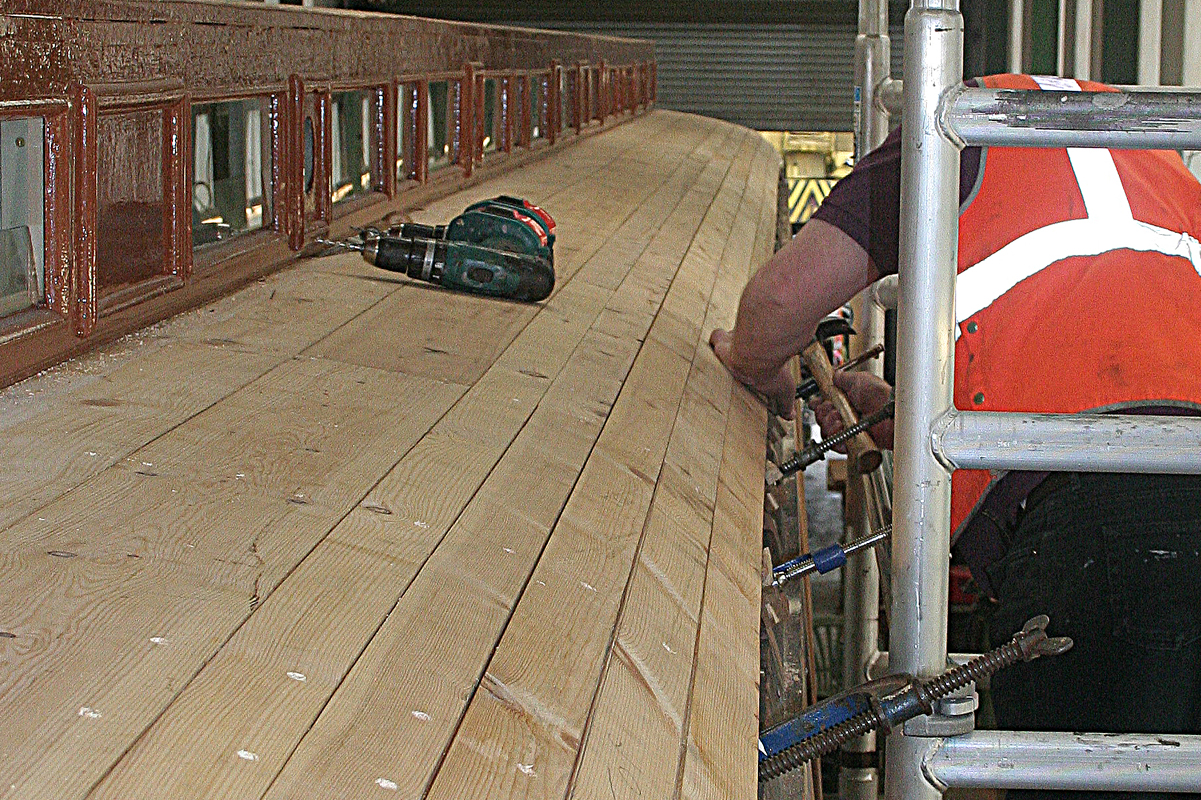
Marcus Woodcock installs the board on the lower clerestory roof section. At each carline, he clamps a block of wood to the cantrail, leaving a gap for a triangular wedge. By hitting the wedge, this then forces the board tighter into the previous one. The newly painted teak brown clerestory upper section sides can be viewed. Photo: Murray Brown.
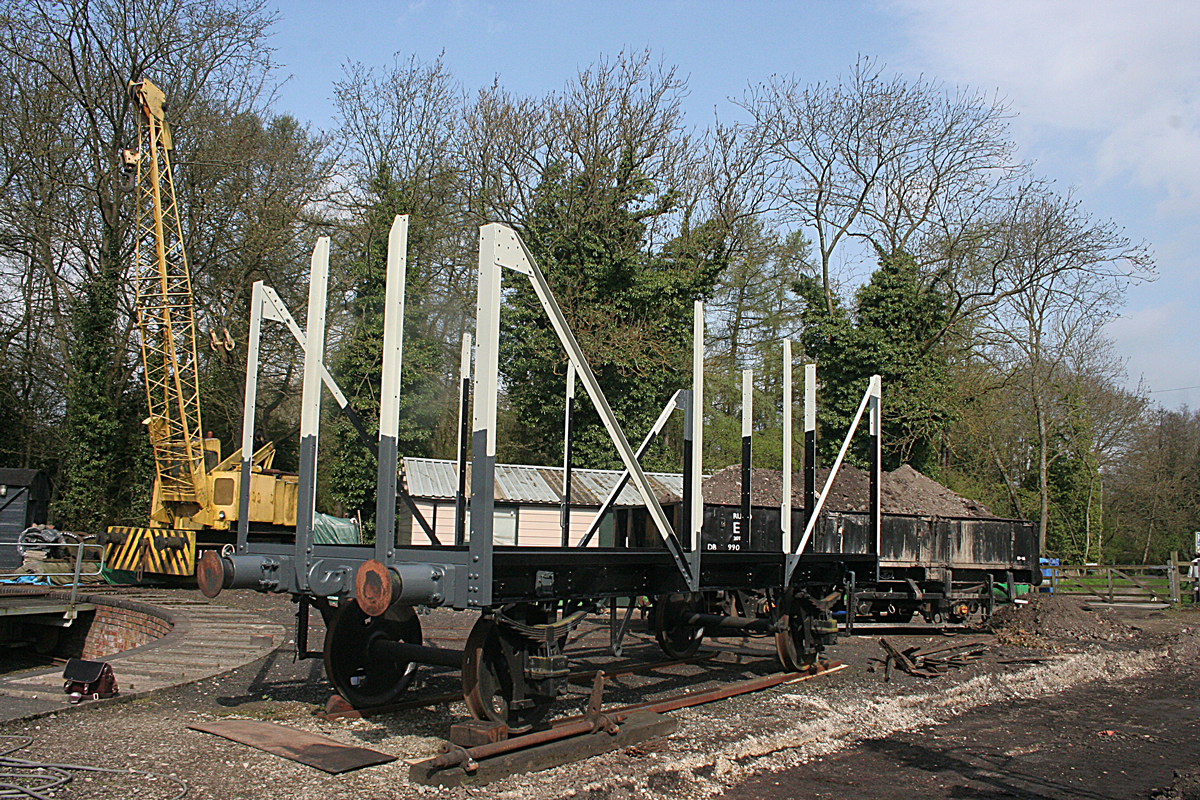
It is good to see work underway on the important Fish Van – not because it is a unique vehicle, but its use is urgently needed for storing major components. With the ‘Pullman Siding’ being dug out and new rail installed, this has allowed a view from the east – previously obstructed by the BR blue GUV stores vehicle. Once the painting is completed, the brake cylinder will be fitted, followed by the vacuum pipe. Photo: Murray Brown.
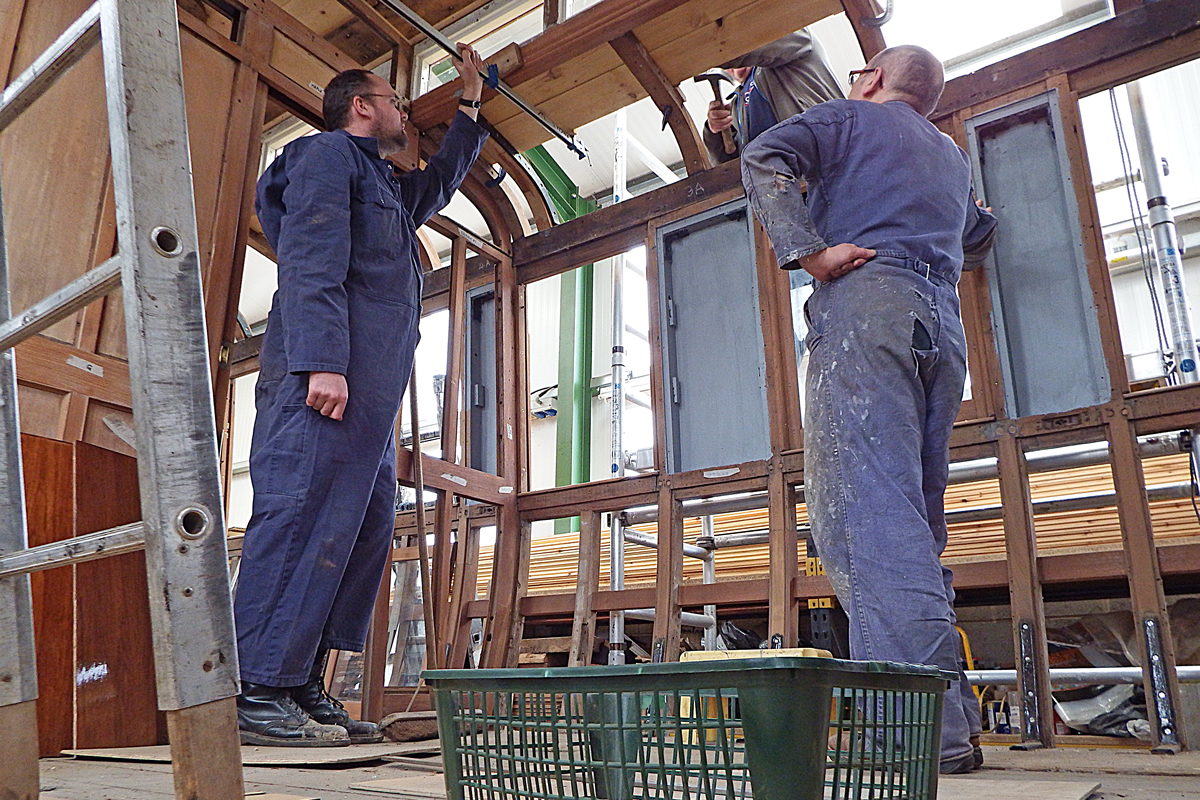
The second of the lower clerestory roof boards is seen being fitted. Also on view is the clamp which ensure this second board is as tight as it can be to the first one. Photo: Malcolm Brown
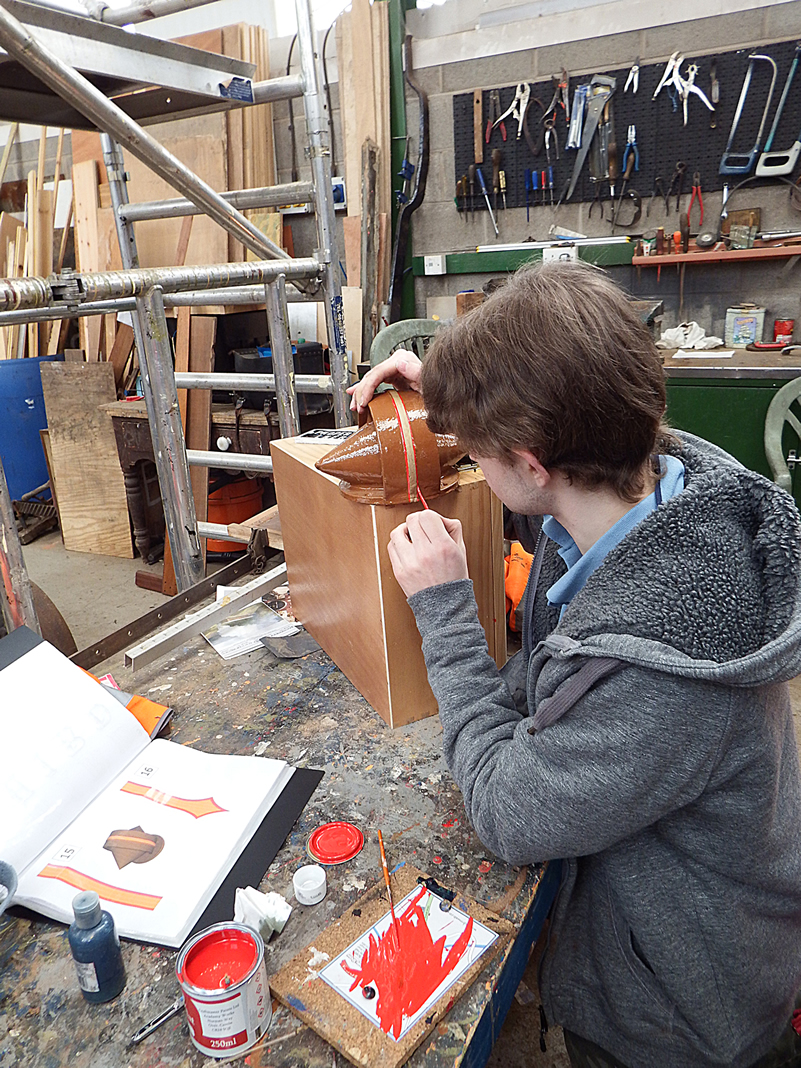
Christopher Johnson carefully adds the lining to one of the ventilators destined for the roof of RTO No. 189. Photo: Malcom Brown.
Nearly ready to re-roof No. 189 – Mar 2018
With all the clerestory glass in place, duly beaded and sealed, thoughts are turning to re-board the lower sides of the roof. To date, this work has been deferred to allow ladders access through the spaces between the carlines in order to gain access to fit the clerestory windows.
The roof has quite a sharp slope when it curves down to join the cantrail. This will necessitate narrow tongue and groove boards to allow them to fit the curvature. It may also mean chamfering off slivers of the tongue, again, to allow these boards to fit tightly against each other and not have any gaps which would allow water ingress. Of course, a canvas will cover these roof boards – or, to be more correct, a heavy-duty plastic sheet.
Whilst the roof boards are yet to be fitted, the gaps left between the carlines – the metal/wood supports of the clerestory roof – are being utilized to put ladders through so that the entire glazed clerestory section can be painted in white undercoat – see image.
With more internal panelling cut out, ready to be varnished and lined up all along the interior, this is a real visual indication of how 189 will be transformed this year.
Another indication of how resplendent 189 will finally look is the application of gold leaf to certain panels – to be undertaken by Neil Cawthorne, resident veneer expert.
The refurbished and shortened underframe for 189 was brought into Pickering yard for further work to be undertaken before the body of 189 is rolled onto it. This involved removing two brake cylinders belonging to a lady at the Bolton Abbey Steam Railway (ex Yorkshire Dales Railway).
Fish Van E75169
Whilst at DC Engineering, Shildon, the repaired frame was spray painted but as this was more of a protective coat, it has been decided to repaint the van in our normal fashion – green anti-oxide, grey undercoat and black top coat. This is a long job when you consider all the framing and supports which make up the underframe. The vertical stanchions will be painted glass white – as will all the body when finally assembled.
Positive progress was made on Saturday February 17 when the eight brake hangers were fitted to the underframe – the first components so fitted – again see image.
TTO No. 56856
This Gresley Owners’ Group (GOG) carriage was still in the paintshop at mid February, but well on the way to completion. The roof has received a new coat of white – this time using Sikagard which is the replacement product for the longer available Decadex.
Vandal repair update
RB 641 is soon to be transported to the Ecclesbourne Valley Railway, north of Derby, where it will stay for all of 2018, receiving maintenance and repair to the vandal damage inflicted upon it last July.
Meanwhile, Nick Stringer and Gordon Wells paid a visit to a Sheffield company on Monday February 19 which specialises in 3D printing. Our interest concerns making the lampshades for the shoulder lights in the Thompson TK 1623. Most of these were smashed to pieces by the vandals – each lampshade cost £30 to be specially made by an Essex glass manufacturer.
The Trust Board was advised at its meeting on February 9 that the first court hearing for the alleged perpetrators of the vandal damage last July was due to be heard on March 1.
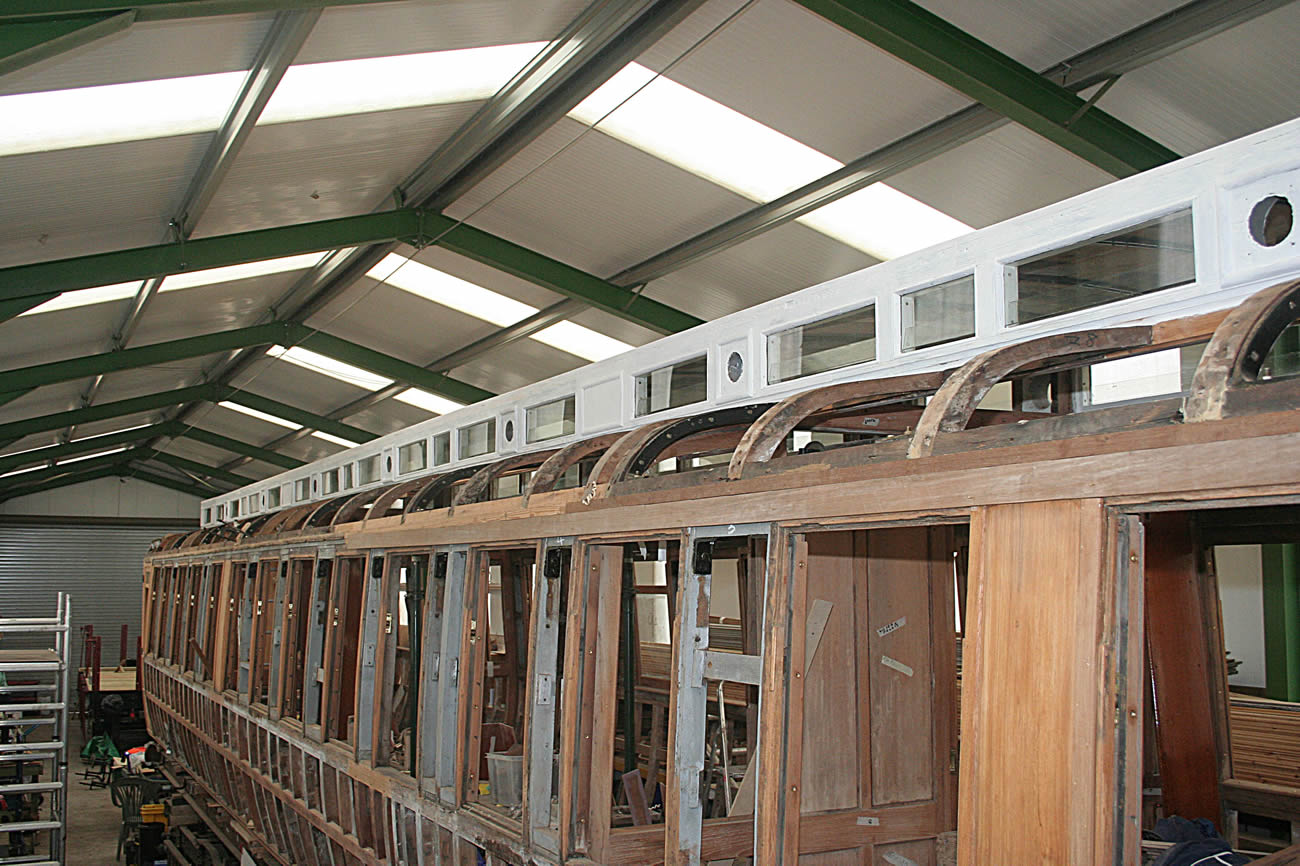
It’s taking shape at last – now that all the clerestory windows are installed and beaded in, the entire sections, on both sides, have been painstakingly painted in white primer.
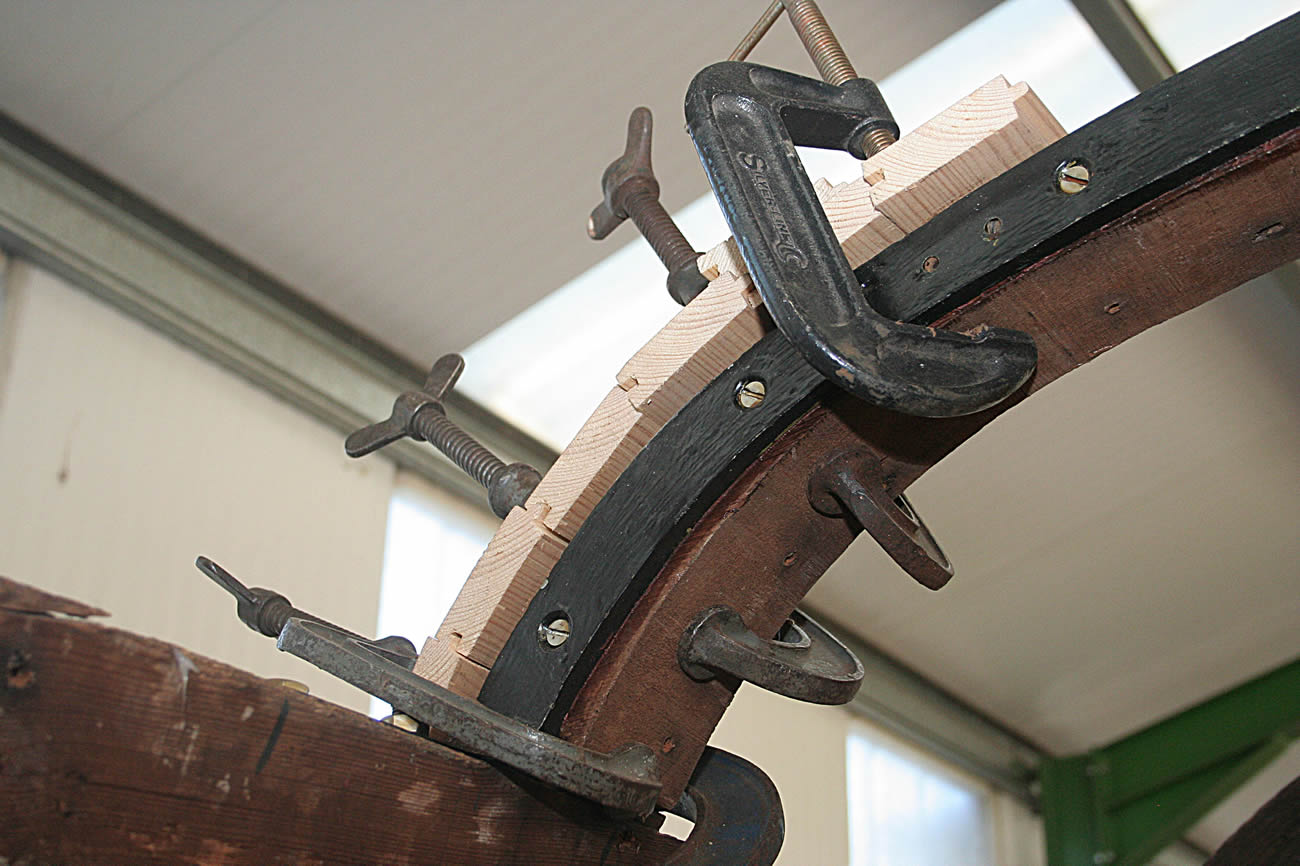
Next job is fitting the remaining roof boards to the lower (beneath the clerestory) sections of the roof. Because of the tight curvature towards the cantrail, a trial has been undertaken – as seen here – to ensure the tongue & groove boards fit tightly. The idea is to ensure there are no gaps between the boards. These roof boards will eventually be covered by a heavy duty sheet.
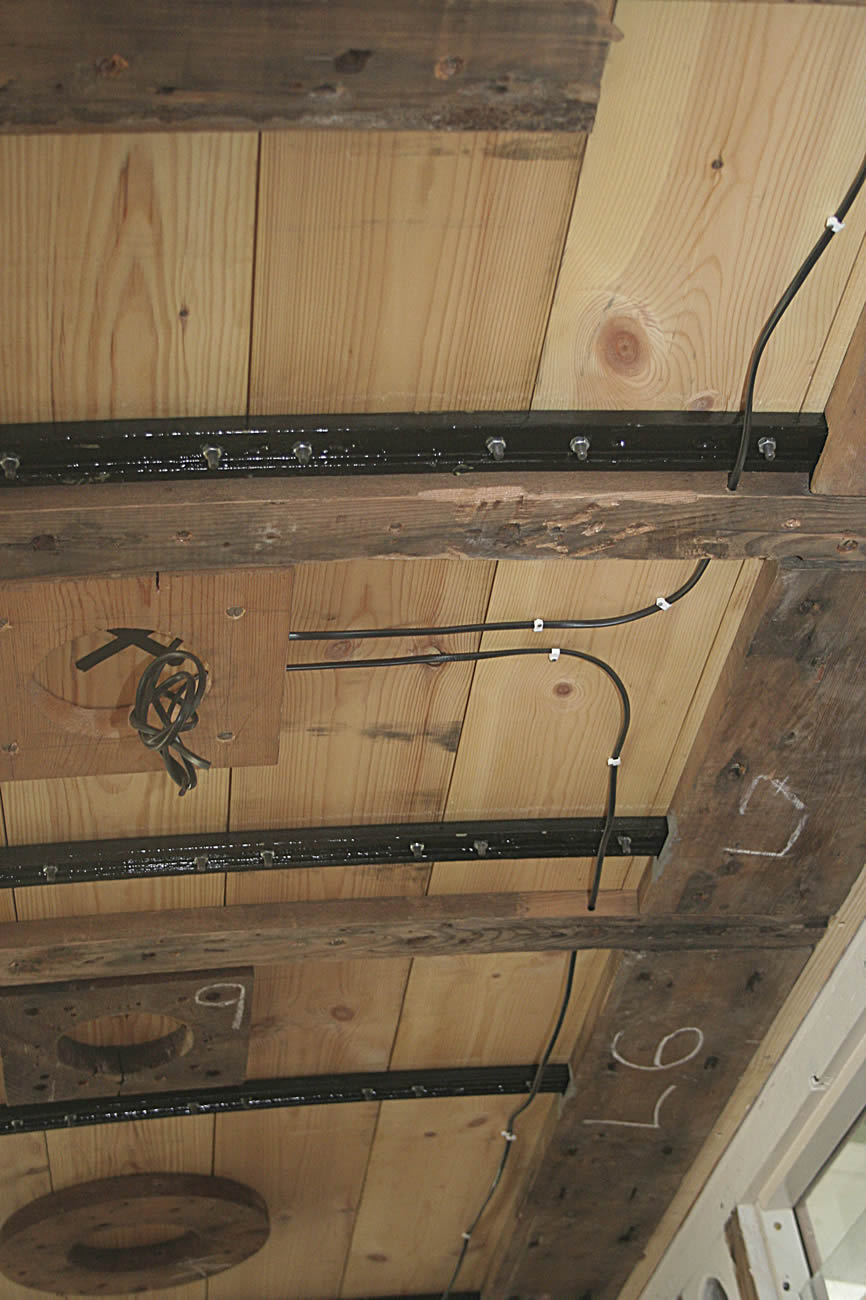
Another sign of progress, but one which will be covered over and not seen, is the wiring. The intention is to fit replica gasoliers, not piped with gas, but with L.E.D lights.
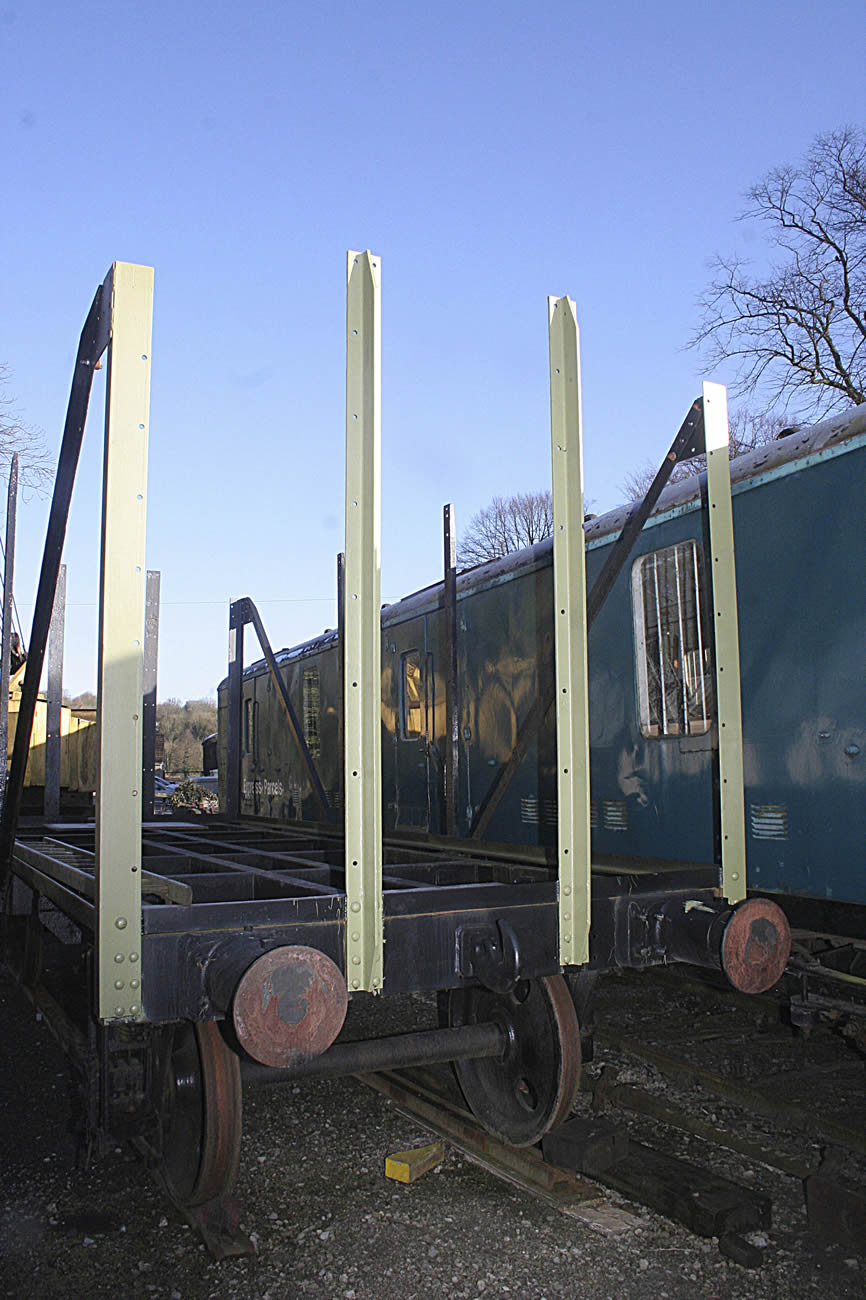
A start has been made on painting the Fish Van – it will receive the normal three coats – green anti-oxide primer, grey undercoat and black top coat. The vertical stanchions will be white.
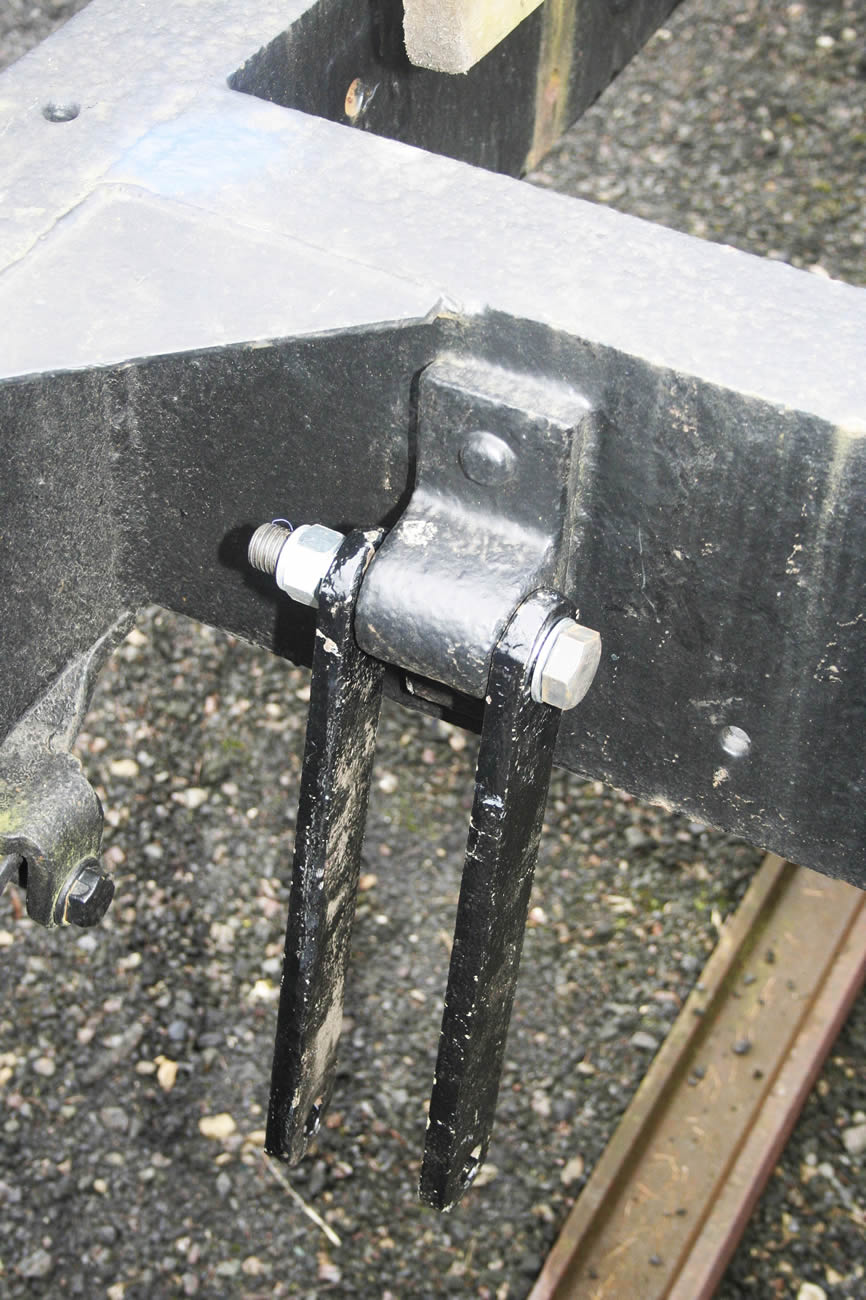
The first components for the underframe have been installed – the eight brake hangers. These support the brake blocks, eight new ones of which will be required in due course. The first brake hanger is pictured after fitting – it is still be have its split pin inserted through the hole in the bolt thread (to prevent the nut from unscrewing and dropping off).
2018 – the year of the Fish Van – Jan 2018
This year should see major progress on rebuilding the sole-surviving LNER-designed Fish Van to Diagram 214 – No. E75169. 2018 is the 70th anniversary of E75169 leaving Faverdale Works, Darlington, brand new.
The vacuum brake cylinder is now in the throes of rebuilding with new components – to be fitted as soon as completed in the workshop.
Brake hanger bolts have been sourced – the hangers, too, will soon be in situ.
As soon as our joiner has completed work on the Beavertail carriage at Burton-on-Trent, the Fish Van frame rebuild is his next job.
On Monday January 22, the Fish Van was inspected by an adjudicator from the Transport Trust to whom the LNERCA has applied for one of the TT’s annual grant awards.
Members and readers are cordially invited to send in a donation towards this unique piece of rolling stock, intrinsically linked with Whitby and the line through Pickering. Please contact Murray Brown if interested in supporting this project – email: murraythemint@ntlworld.com
ECJS Restaurant Third No. 189
After years of appearing derelict, this Victorian carriage is now looking more and more like a railway carriage. With virtually all the clerestory glass and associated beading in place, the remaining roof boards are next to be fitted.
Meanwhile, two windows are in place and much of the plywood panels have been cut out and have received the first coats of varnish.
Where one enters the carriage, the vestibule has been painted with Le Tonkinois varnish as recommended by our expert veneering and varnish volunteer, Neil Cawthorne. This varnish far excels anything else on the market. When completed, with gold leaf, visitors and passengers will be truly amazed at the workmanship and finish when they enter the carriage.
Completed CAD drawings have been supplied by David Elliott (A1 Trust Engineer) to his usual superlative standard. (see illustration below). These show the entire underframe with all fittings, including the placing of the two brake cylinders on the same side. The underframe is to be brought into Pickering yard imminently so that various jobs can be undertaken before the body of 189 is rolled onto it. Top hat fixings have been ordered – these bolt onto the underframe and permit the body to be anchored onto the underframe when in place. The ‘big roll’ when 189’s body is rolled from its existing non-standard underframe onto the newly modified one is scheduled for March. This will be a landmark stage in 189’s restoration.
TTO No. 56856
At the end of January, C&W painter, Mark Toyne has completed the varnishing of this TTO to the extent of needing the new transfers applying. Accordingly, from the warm confines of storage, 56856 x 2, LNER x 2 and ‘3’ x 4 (for the four doors) were extracted. More varnish will be applied once these transfers have been slid into place.
Next for attention should be BTO 43567. This carriage has been deputising in the Pullman set whilst Car No. 79 is away for serious roof repairs.
CCT E1308
A good start has been made on repaneling this 1950-built CCT – donated to us from Doncaster Works in July 1996 after the Doncaster Works Horticultural Society – who used the van – was disbanded. It has been decided to paint the van in LNER brown rather than the maroon in which was originally built. Once completed, the van is likely to be placed in what was the beck siding at the north end of platform 1. This is now devoid of rail because of the removal of the points – worn out and replaced by plain rail. It is likely the Upholstery carriage – 42969 – will also be placed next to E1308, also painted in LNER brown in due course. This will allow easy access by both LNERCA volunteers and C&W staff.
E1308 has now been shunted back into the Long Siding to allow the ‘new’ underframe destined for ECJS 189 to be brought into Pickering yard. The plan is for E1308 to return to Pickering yard later this year when space permits to enable further renewal of the body. Meanwhile, work will continue inside the Atkins shed on rebuilding E1308’s doors.
Vandal repair update
The damaged RB 641 is soon to be sent away to a contractor where the serious damage will be put right and various maintenance jobs undertaken. It has taken a long time to decide where the coach should be sent for repairs. It will not return until 2019. This will have repercussions on the catering aspects of the NYMR, one result of which is a reduction in the number of curry trains which will be able to be run in 2018.
Another carriage will is taking months to repair is the unique Thompson TK 1623 wherein most of the compartment shoulder lights were smashed to bits. The seven components in each shoulder light had to be specially made when we restored this carriage – and nothing has changed. Each lampshade cost us £30, let alone all the other components. There are 28 shoulder lights in this carriage, most of which were wrecked.
Shaun Kay at Grosmont shed has produced a toggle switch will be the forerunner of a batch to be made. We are still nowhere near finding manufacturers for the other parts as some have ceased production since 1623 was first restored.
We understand there is to be a court case for the alleged perpetrators of this vandalism.
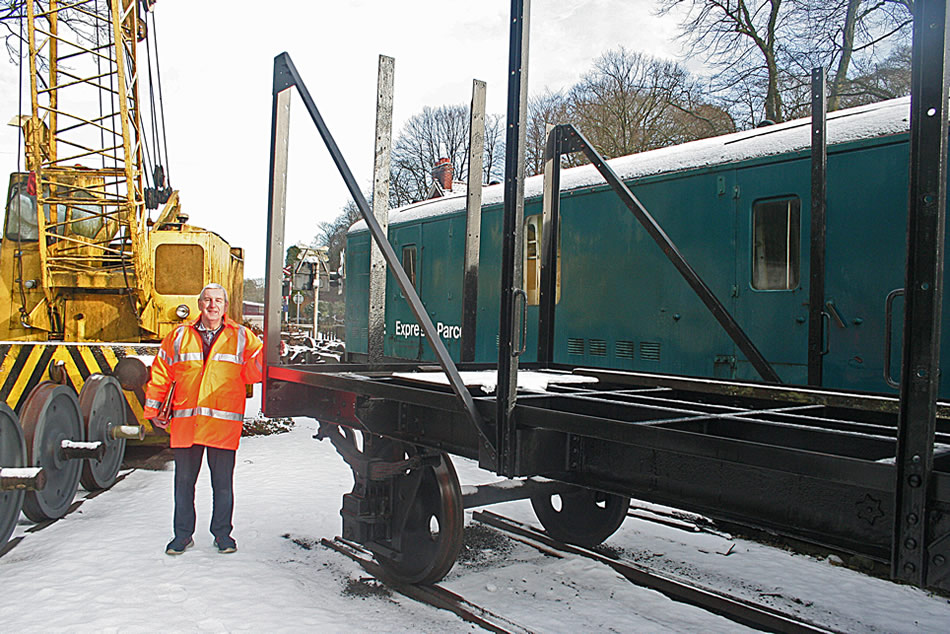
The Transport Trust’s adjudicator, Rob Shoreland-Ball, inspects the LNERCA’s skeletal Fish Van frame on January 22. One of the main criteria for applicants for this annual grant awarding is that the item’s restoration must be in progress and on-going – which the Fish Van definitely is. Mr Shoreland-Ball was formerly the Deputy Curator at the NRM, York.
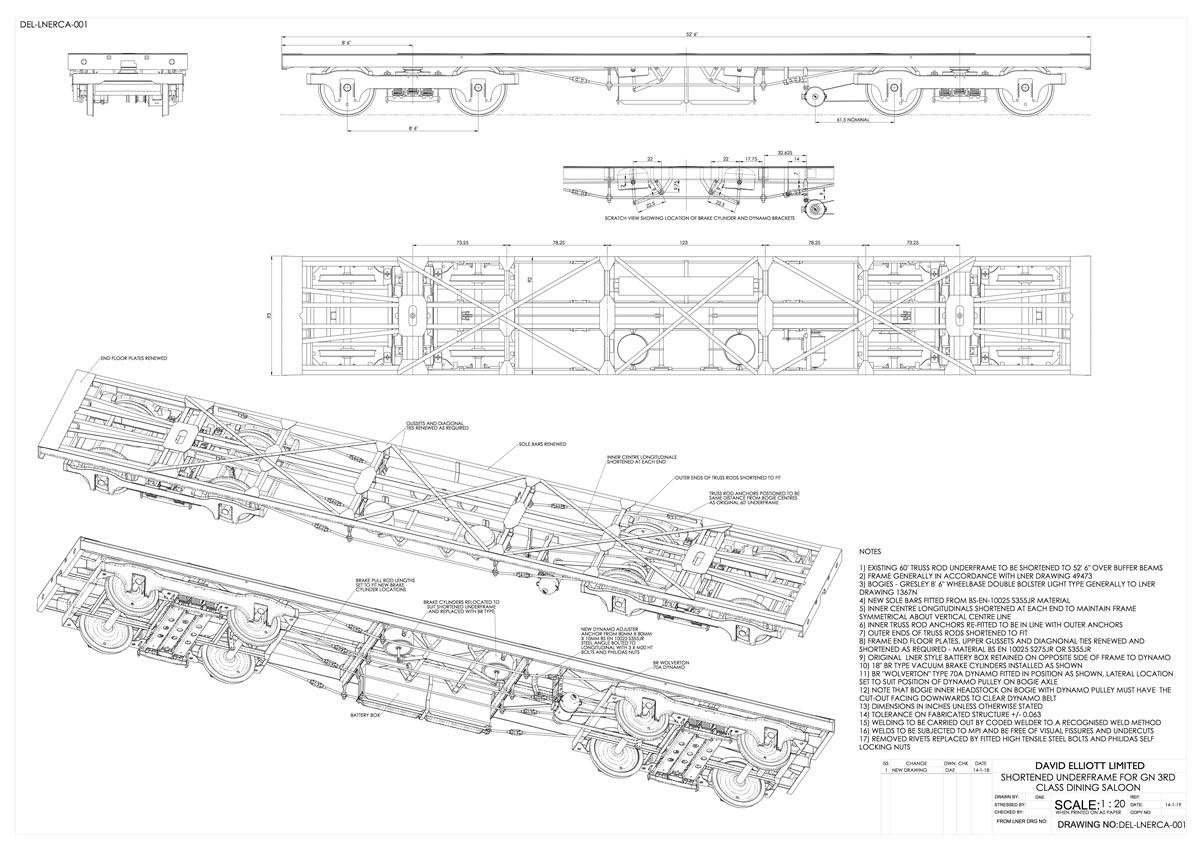
These are the quality CAD drawings of the underframe destined to be placed under ECJS 189. They were drawn by David Elliott, Chief Designer of the A1 Steam Trust, currently building the new P2 locomotive. An immense amount of work has gone into the design of the underframe – remember, this was originally a standard 61’6”Gresley underframe, duly shortened, with brand new solebars welded onto the top of the frames. Note the Gresley bogies. Whilst the LNERCA finally managed to secure a pair of genuine Fox bogies (on which 189 was originally built), the tyre sizes precludes the Fox bogies’ fitting – until, we are able to re-tyre the wheelsets. So, for the time being, Gresley bogies will be utilised.

